Different Types and Purposes of Organisations
VerifiedAdded on 2023/01/17
|21
|5827
|2
AI Summary
This document explains the different types and purposes of organisations in the business environment, including private, public, and voluntary sectors. It also discusses the size and scope of these organisations and their legal structures.
Contribute Materials
Your contribution can guide someone’s learning journey. Share your
documents today.
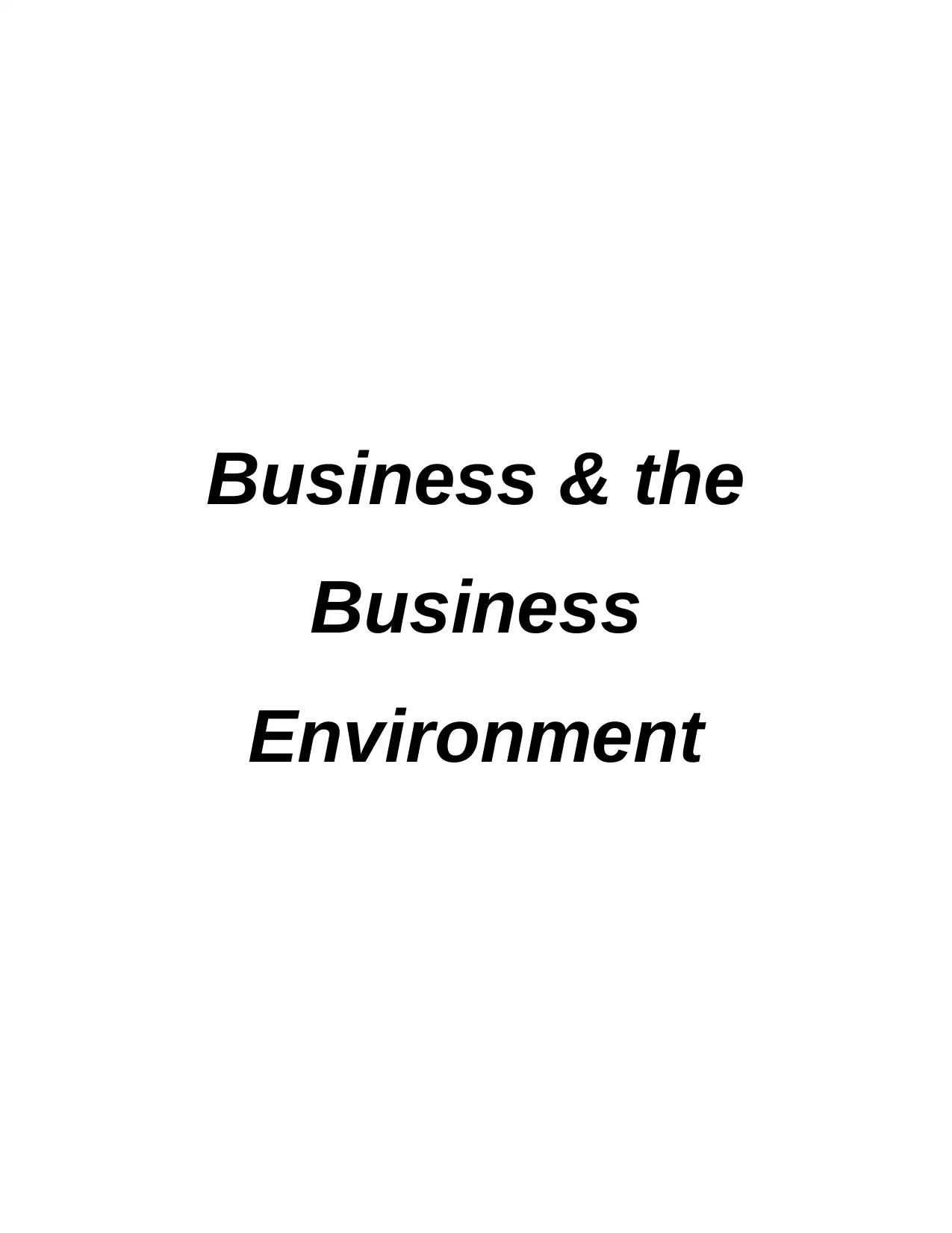
Business & the
Business
Environment
Business
Environment
Secure Best Marks with AI Grader
Need help grading? Try our AI Grader for instant feedback on your assignments.
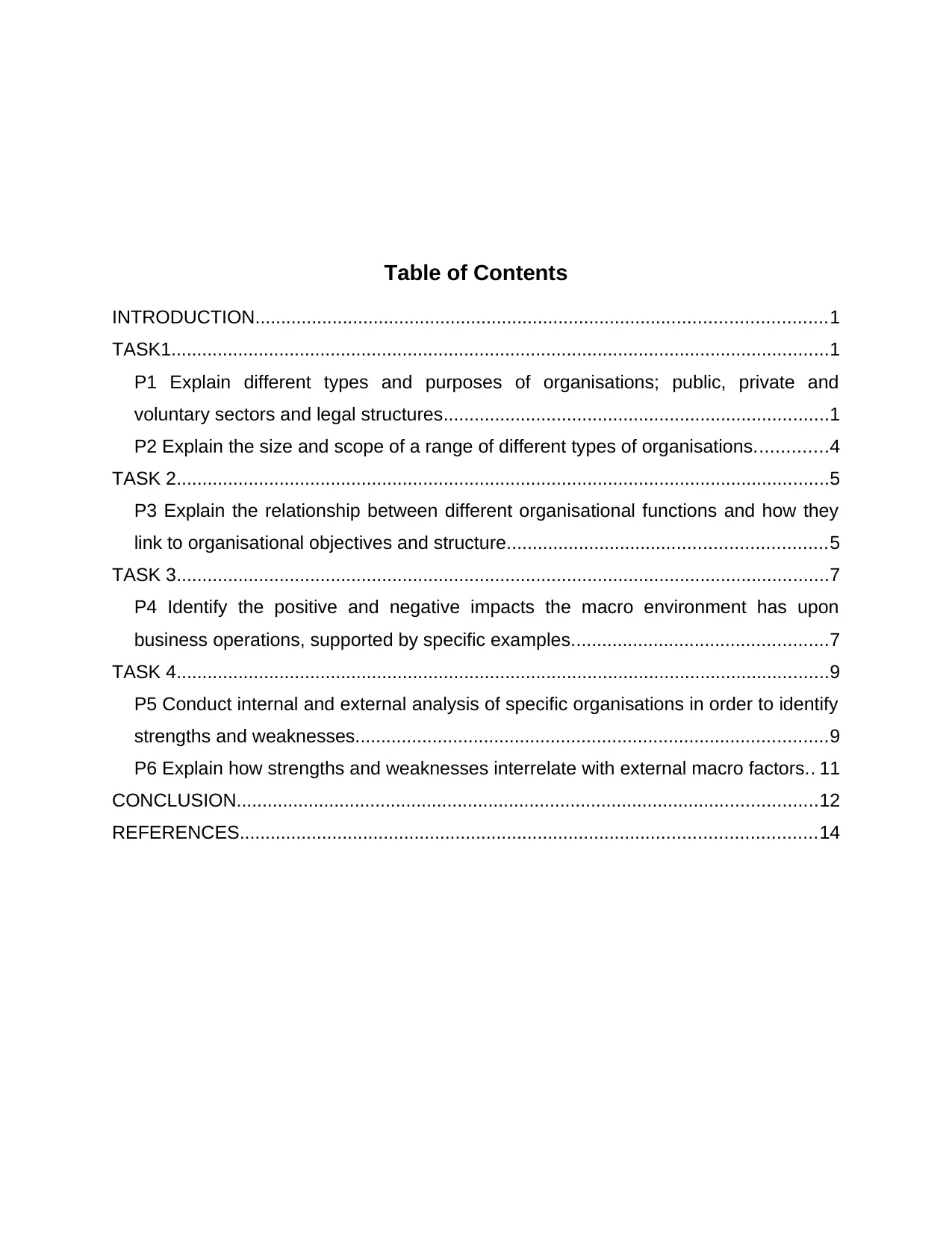
Table of Contents
INTRODUCTION...............................................................................................................1
TASK1................................................................................................................................1
P1 Explain different types and purposes of organisations; public, private and
voluntary sectors and legal structures...........................................................................1
P2 Explain the size and scope of a range of different types of organisations..............4
TASK 2...............................................................................................................................5
P3 Explain the relationship between different organisational functions and how they
link to organisational objectives and structure..............................................................5
TASK 3...............................................................................................................................7
P4 Identify the positive and negative impacts the macro environment has upon
business operations, supported by specific examples..................................................7
TASK 4...............................................................................................................................9
P5 Conduct internal and external analysis of specific organisations in order to identify
strengths and weaknesses............................................................................................9
P6 Explain how strengths and weaknesses interrelate with external macro factors.. 11
CONCLUSION.................................................................................................................12
REFERENCES................................................................................................................14
INTRODUCTION...............................................................................................................1
TASK1................................................................................................................................1
P1 Explain different types and purposes of organisations; public, private and
voluntary sectors and legal structures...........................................................................1
P2 Explain the size and scope of a range of different types of organisations..............4
TASK 2...............................................................................................................................5
P3 Explain the relationship between different organisational functions and how they
link to organisational objectives and structure..............................................................5
TASK 3...............................................................................................................................7
P4 Identify the positive and negative impacts the macro environment has upon
business operations, supported by specific examples..................................................7
TASK 4...............................................................................................................................9
P5 Conduct internal and external analysis of specific organisations in order to identify
strengths and weaknesses............................................................................................9
P6 Explain how strengths and weaknesses interrelate with external macro factors.. 11
CONCLUSION.................................................................................................................12
REFERENCES................................................................................................................14

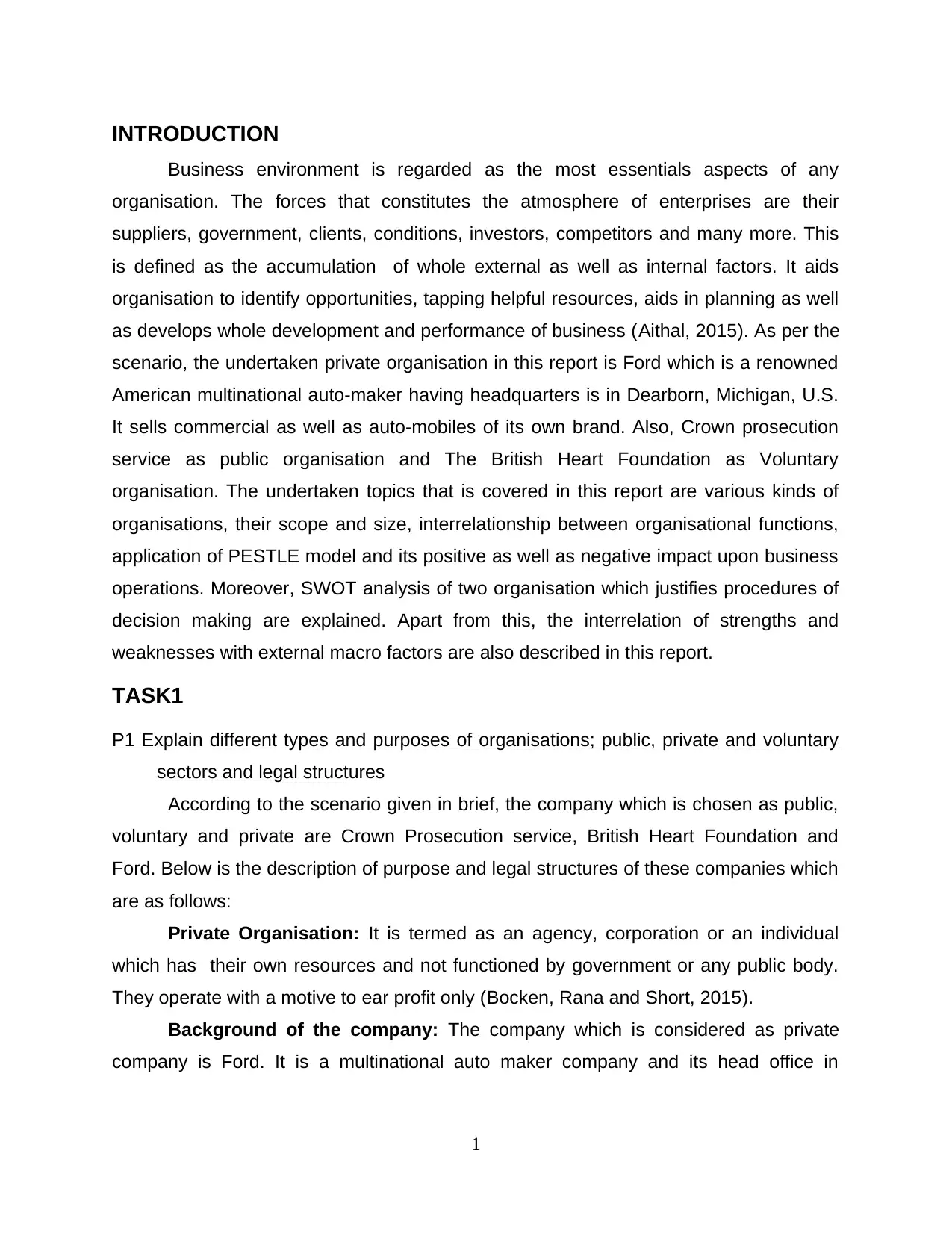
INTRODUCTION
Business environment is regarded as the most essentials aspects of any
organisation. The forces that constitutes the atmosphere of enterprises are their
suppliers, government, clients, conditions, investors, competitors and many more. This
is defined as the accumulation of whole external as well as internal factors. It aids
organisation to identify opportunities, tapping helpful resources, aids in planning as well
as develops whole development and performance of business (Aithal, 2015). As per the
scenario, the undertaken private organisation in this report is Ford which is a renowned
American multinational auto-maker having headquarters is in Dearborn, Michigan, U.S.
It sells commercial as well as auto-mobiles of its own brand. Also, Crown prosecution
service as public organisation and The British Heart Foundation as Voluntary
organisation. The undertaken topics that is covered in this report are various kinds of
organisations, their scope and size, interrelationship between organisational functions,
application of PESTLE model and its positive as well as negative impact upon business
operations. Moreover, SWOT analysis of two organisation which justifies procedures of
decision making are explained. Apart from this, the interrelation of strengths and
weaknesses with external macro factors are also described in this report.
TASK1
P1 Explain different types and purposes of organisations; public, private and voluntary
sectors and legal structures
According to the scenario given in brief, the company which is chosen as public,
voluntary and private are Crown Prosecution service, British Heart Foundation and
Ford. Below is the description of purpose and legal structures of these companies which
are as follows:
Private Organisation: It is termed as an agency, corporation or an individual
which has their own resources and not functioned by government or any public body.
They operate with a motive to ear profit only (Bocken, Rana and Short, 2015).
Background of the company: The company which is considered as private
company is Ford. It is a multinational auto maker company and its head office in
1
Business environment is regarded as the most essentials aspects of any
organisation. The forces that constitutes the atmosphere of enterprises are their
suppliers, government, clients, conditions, investors, competitors and many more. This
is defined as the accumulation of whole external as well as internal factors. It aids
organisation to identify opportunities, tapping helpful resources, aids in planning as well
as develops whole development and performance of business (Aithal, 2015). As per the
scenario, the undertaken private organisation in this report is Ford which is a renowned
American multinational auto-maker having headquarters is in Dearborn, Michigan, U.S.
It sells commercial as well as auto-mobiles of its own brand. Also, Crown prosecution
service as public organisation and The British Heart Foundation as Voluntary
organisation. The undertaken topics that is covered in this report are various kinds of
organisations, their scope and size, interrelationship between organisational functions,
application of PESTLE model and its positive as well as negative impact upon business
operations. Moreover, SWOT analysis of two organisation which justifies procedures of
decision making are explained. Apart from this, the interrelation of strengths and
weaknesses with external macro factors are also described in this report.
TASK1
P1 Explain different types and purposes of organisations; public, private and voluntary
sectors and legal structures
According to the scenario given in brief, the company which is chosen as public,
voluntary and private are Crown Prosecution service, British Heart Foundation and
Ford. Below is the description of purpose and legal structures of these companies which
are as follows:
Private Organisation: It is termed as an agency, corporation or an individual
which has their own resources and not functioned by government or any public body.
They operate with a motive to ear profit only (Bocken, Rana and Short, 2015).
Background of the company: The company which is considered as private
company is Ford. It is a multinational auto maker company and its head office in
1
Secure Best Marks with AI Grader
Need help grading? Try our AI Grader for instant feedback on your assignments.

Michigan, Detroit. The company was proposed by Henry Ford in year 1903. The
company have more than 66 plants globally and have around 1,80,000 staff members.
Products & Services: Its products involves commercial vehicles, pickup trucks,
automotive parts, luxury vehicles, SUVs and many more. The services of Ford are
Vehicle leasing, Automotive finance and Vehicle service.
Objectives: The objective of the company is to develop those vehicles which
reduce the consumption of oil and to increase usage of Bio-fuels.
Vision: The vision statement of Ford is “ To become leading and trusted
company in the world which designs smart vehicles for smart customers” .
Mission- The mission is “To produce outstanding products which improves and
develops people's lives”.
Types of private organisation Sole Proprietorship: The business which is operated and function by a single
entity. It has been stated that it is the most easiest and convenient form of
business. The person is responsible for all the losses and debts (Burns, 2016).
Joint Stock Company: This company can either be private as well as public. Joint
stock company is managed and controlled by chief executives and board of
directors. The company have limited liability and the risk of these companies is
high.
Purpose: The main purpose is to assemble people together. With this, to serve
better quality of products to customer in order to gain trust of people and become the
leading company in these sector.
Legal Structure of company: It is determine that the overall legal structure of
company is rely upon the functions as well as operations performed by an organisation.
In relation to Ford, it make use of private limited company structure, in addition to ths, all
the decisions are taken by the higher authorities of company that is CEO, BoD and
oeners of company. It is analysed that the decisions taken by company is depend on
the external and internal factors. In Private limited companies, there is one or more
owners and shareholders as well. In addition to this, in such legal structure the transfer
of share is prohibited. Moreover, owner of the company is enjoy greater capital and
2
company have more than 66 plants globally and have around 1,80,000 staff members.
Products & Services: Its products involves commercial vehicles, pickup trucks,
automotive parts, luxury vehicles, SUVs and many more. The services of Ford are
Vehicle leasing, Automotive finance and Vehicle service.
Objectives: The objective of the company is to develop those vehicles which
reduce the consumption of oil and to increase usage of Bio-fuels.
Vision: The vision statement of Ford is “ To become leading and trusted
company in the world which designs smart vehicles for smart customers” .
Mission- The mission is “To produce outstanding products which improves and
develops people's lives”.
Types of private organisation Sole Proprietorship: The business which is operated and function by a single
entity. It has been stated that it is the most easiest and convenient form of
business. The person is responsible for all the losses and debts (Burns, 2016).
Joint Stock Company: This company can either be private as well as public. Joint
stock company is managed and controlled by chief executives and board of
directors. The company have limited liability and the risk of these companies is
high.
Purpose: The main purpose is to assemble people together. With this, to serve
better quality of products to customer in order to gain trust of people and become the
leading company in these sector.
Legal Structure of company: It is determine that the overall legal structure of
company is rely upon the functions as well as operations performed by an organisation.
In relation to Ford, it make use of private limited company structure, in addition to ths, all
the decisions are taken by the higher authorities of company that is CEO, BoD and
oeners of company. It is analysed that the decisions taken by company is depend on
the external and internal factors. In Private limited companies, there is one or more
owners and shareholders as well. In addition to this, in such legal structure the transfer
of share is prohibited. Moreover, owner of the company is enjoy greater capital and
2

have limited liability. The company is following the legal structure of a private
organisation as it consist of more than 1,80,000 employees.
Stakeholders- The stakeholders of company is suppliers, groups, creditors,
customers, communities and may more.
Public Organisation: The company which is managed and controlled by
government. These are those company which have more than 50 percent share is
owned by public. This organisations are funded by government as well as public (Demil
and et. al, 2015).
Background of the company: Crown prosecution service is a public agency
which conducts prosecution in Wales as well as England. The company head office in
London and have around 6,000 subordinates. The CEO of company is Max Hill and it
was founded in year 1986.
Products & Services: The company serve legal advice to investigate agencies
and to police in order to decide criminal charges of a suspect.
Objectives: The main motive of the agency is to punish right person and provide
justice to offenders.
Vision: The vision is to bring equality in societies and to punish criminal so that
population of the country live independently and feel security in society.
Mission- The organisation mission is to provide justice by effective &
independent persecution. In addition to this, the company want to foster a culture by
inspiring and motivating people of society.
Types of Public organisation: Departmental Undertakings: This organisation have existence with government
and it is mainly act as a sector of government (Deng and Wang, 2016). For
example, Broadcasting, Telephone and railway services. Government Company: The company whose 51 percent shares or more than it
are owned by the state or central or partly by both. These are those organisation
which activities are managed and take place with the permission and order of
government.
Public Corporation- It is formed through special act of central or state or
parliaments. Example, state banks, Airlines and so on.
3
organisation as it consist of more than 1,80,000 employees.
Stakeholders- The stakeholders of company is suppliers, groups, creditors,
customers, communities and may more.
Public Organisation: The company which is managed and controlled by
government. These are those company which have more than 50 percent share is
owned by public. This organisations are funded by government as well as public (Demil
and et. al, 2015).
Background of the company: Crown prosecution service is a public agency
which conducts prosecution in Wales as well as England. The company head office in
London and have around 6,000 subordinates. The CEO of company is Max Hill and it
was founded in year 1986.
Products & Services: The company serve legal advice to investigate agencies
and to police in order to decide criminal charges of a suspect.
Objectives: The main motive of the agency is to punish right person and provide
justice to offenders.
Vision: The vision is to bring equality in societies and to punish criminal so that
population of the country live independently and feel security in society.
Mission- The organisation mission is to provide justice by effective &
independent persecution. In addition to this, the company want to foster a culture by
inspiring and motivating people of society.
Types of Public organisation: Departmental Undertakings: This organisation have existence with government
and it is mainly act as a sector of government (Deng and Wang, 2016). For
example, Broadcasting, Telephone and railway services. Government Company: The company whose 51 percent shares or more than it
are owned by the state or central or partly by both. These are those organisation
which activities are managed and take place with the permission and order of
government.
Public Corporation- It is formed through special act of central or state or
parliaments. Example, state banks, Airlines and so on.
3

Purpose- The purpose is to promote awareness in societies and make them
people feel secure at there places.
Legal Structure- The company follows the legal structure of public organisation
as it is funded by the public or government body. In Public limited companies, there are
more then two owners and shareholders as well. In addition to this, can sell share to the
general public. Moreover, in public limited companies, there is ease of share transfer
and is gain benefit of greater continuity. It is analysed that set up of a public company is
expensive and is less flexible as well.
Stakeholders: The stakeholders of company is local authorities, non-police
prosecutors, police, legal agency, bulk users, HMPPS and many more.
Voluntary Organisation: It is refer as a group of people who came into an
agreement to attain a common purpose. Basically, these people are the volunteers who
assemble together for a particular period of time or for a specific project ( Dyllick and
Muff, 2016). For instance, environmental groups, trade associations, learned societies
and so on.
Background of the company: BHF is a registered charity organisation which is
founded by medical professionals in year 961. The company served in the region of
United Kingdom and was located in high street.
Services: The foundation were focused towards the increasing rate of people
due to cardiovascular disease. They mainly emphasise on the causes and prevention
of circulatory and heart disease.
Objectives- The objective of British Heart foundation is to reduce the rate of
death which is occurred due to heart problems.
Vision- The vision is to pioneering research, caring and supporting people who
have heart diseases. In addition to this, the organisation want to build awareness and
provide information to people about circulatory disease.
Mission- The mission statement of BHF is “ To make a world where premature
death does not occur due to heart disease”.
Types of voluntary organisation: It includes:
4
people feel secure at there places.
Legal Structure- The company follows the legal structure of public organisation
as it is funded by the public or government body. In Public limited companies, there are
more then two owners and shareholders as well. In addition to this, can sell share to the
general public. Moreover, in public limited companies, there is ease of share transfer
and is gain benefit of greater continuity. It is analysed that set up of a public company is
expensive and is less flexible as well.
Stakeholders: The stakeholders of company is local authorities, non-police
prosecutors, police, legal agency, bulk users, HMPPS and many more.
Voluntary Organisation: It is refer as a group of people who came into an
agreement to attain a common purpose. Basically, these people are the volunteers who
assemble together for a particular period of time or for a specific project ( Dyllick and
Muff, 2016). For instance, environmental groups, trade associations, learned societies
and so on.
Background of the company: BHF is a registered charity organisation which is
founded by medical professionals in year 961. The company served in the region of
United Kingdom and was located in high street.
Services: The foundation were focused towards the increasing rate of people
due to cardiovascular disease. They mainly emphasise on the causes and prevention
of circulatory and heart disease.
Objectives- The objective of British Heart foundation is to reduce the rate of
death which is occurred due to heart problems.
Vision- The vision is to pioneering research, caring and supporting people who
have heart diseases. In addition to this, the organisation want to build awareness and
provide information to people about circulatory disease.
Mission- The mission statement of BHF is “ To make a world where premature
death does not occur due to heart disease”.
Types of voluntary organisation: It includes:
4
Paraphrase This Document
Need a fresh take? Get an instant paraphrase of this document with our AI Paraphraser
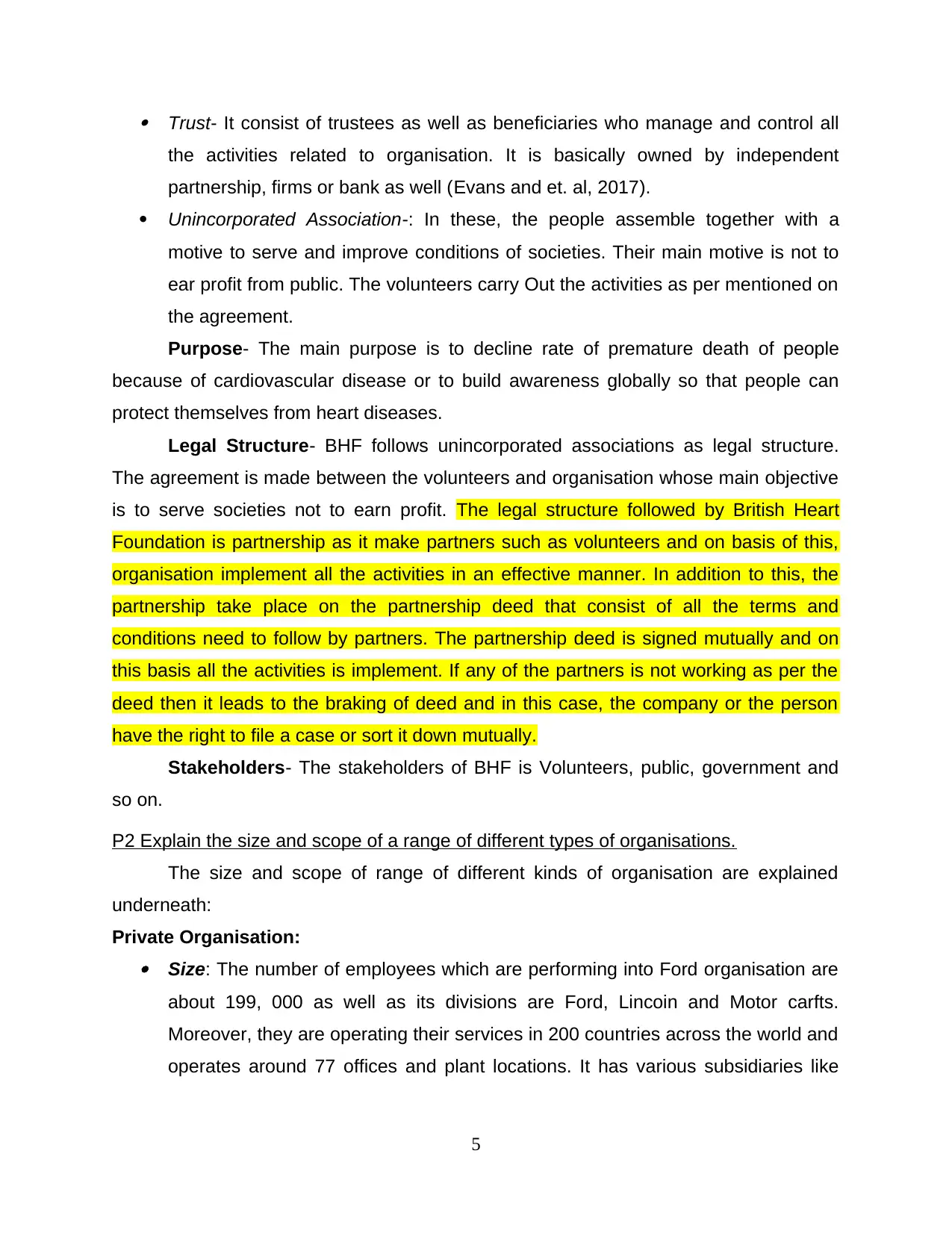
Trust- It consist of trustees as well as beneficiaries who manage and control all
the activities related to organisation. It is basically owned by independent
partnership, firms or bank as well (Evans and et. al, 2017).
Unincorporated Association-: In these, the people assemble together with a
motive to serve and improve conditions of societies. Their main motive is not to
ear profit from public. The volunteers carry Out the activities as per mentioned on
the agreement.
Purpose- The main purpose is to decline rate of premature death of people
because of cardiovascular disease or to build awareness globally so that people can
protect themselves from heart diseases.
Legal Structure- BHF follows unincorporated associations as legal structure.
The agreement is made between the volunteers and organisation whose main objective
is to serve societies not to earn profit. The legal structure followed by British Heart
Foundation is partnership as it make partners such as volunteers and on basis of this,
organisation implement all the activities in an effective manner. In addition to this, the
partnership take place on the partnership deed that consist of all the terms and
conditions need to follow by partners. The partnership deed is signed mutually and on
this basis all the activities is implement. If any of the partners is not working as per the
deed then it leads to the braking of deed and in this case, the company or the person
have the right to file a case or sort it down mutually.
Stakeholders- The stakeholders of BHF is Volunteers, public, government and
so on.
P2 Explain the size and scope of a range of different types of organisations.
The size and scope of range of different kinds of organisation are explained
underneath:
Private Organisation: Size: The number of employees which are performing into Ford organisation are
about 199, 000 as well as its divisions are Ford, Lincoin and Motor carfts.
Moreover, they are operating their services in 200 countries across the world and
operates around 77 offices and plant locations. It has various subsidiaries like
5
the activities related to organisation. It is basically owned by independent
partnership, firms or bank as well (Evans and et. al, 2017).
Unincorporated Association-: In these, the people assemble together with a
motive to serve and improve conditions of societies. Their main motive is not to
ear profit from public. The volunteers carry Out the activities as per mentioned on
the agreement.
Purpose- The main purpose is to decline rate of premature death of people
because of cardiovascular disease or to build awareness globally so that people can
protect themselves from heart diseases.
Legal Structure- BHF follows unincorporated associations as legal structure.
The agreement is made between the volunteers and organisation whose main objective
is to serve societies not to earn profit. The legal structure followed by British Heart
Foundation is partnership as it make partners such as volunteers and on basis of this,
organisation implement all the activities in an effective manner. In addition to this, the
partnership take place on the partnership deed that consist of all the terms and
conditions need to follow by partners. The partnership deed is signed mutually and on
this basis all the activities is implement. If any of the partners is not working as per the
deed then it leads to the braking of deed and in this case, the company or the person
have the right to file a case or sort it down mutually.
Stakeholders- The stakeholders of BHF is Volunteers, public, government and
so on.
P2 Explain the size and scope of a range of different types of organisations.
The size and scope of range of different kinds of organisation are explained
underneath:
Private Organisation: Size: The number of employees which are performing into Ford organisation are
about 199, 000 as well as its divisions are Ford, Lincoin and Motor carfts.
Moreover, they are operating their services in 200 countries across the world and
operates around 77 offices and plant locations. It has various subsidiaries like
5
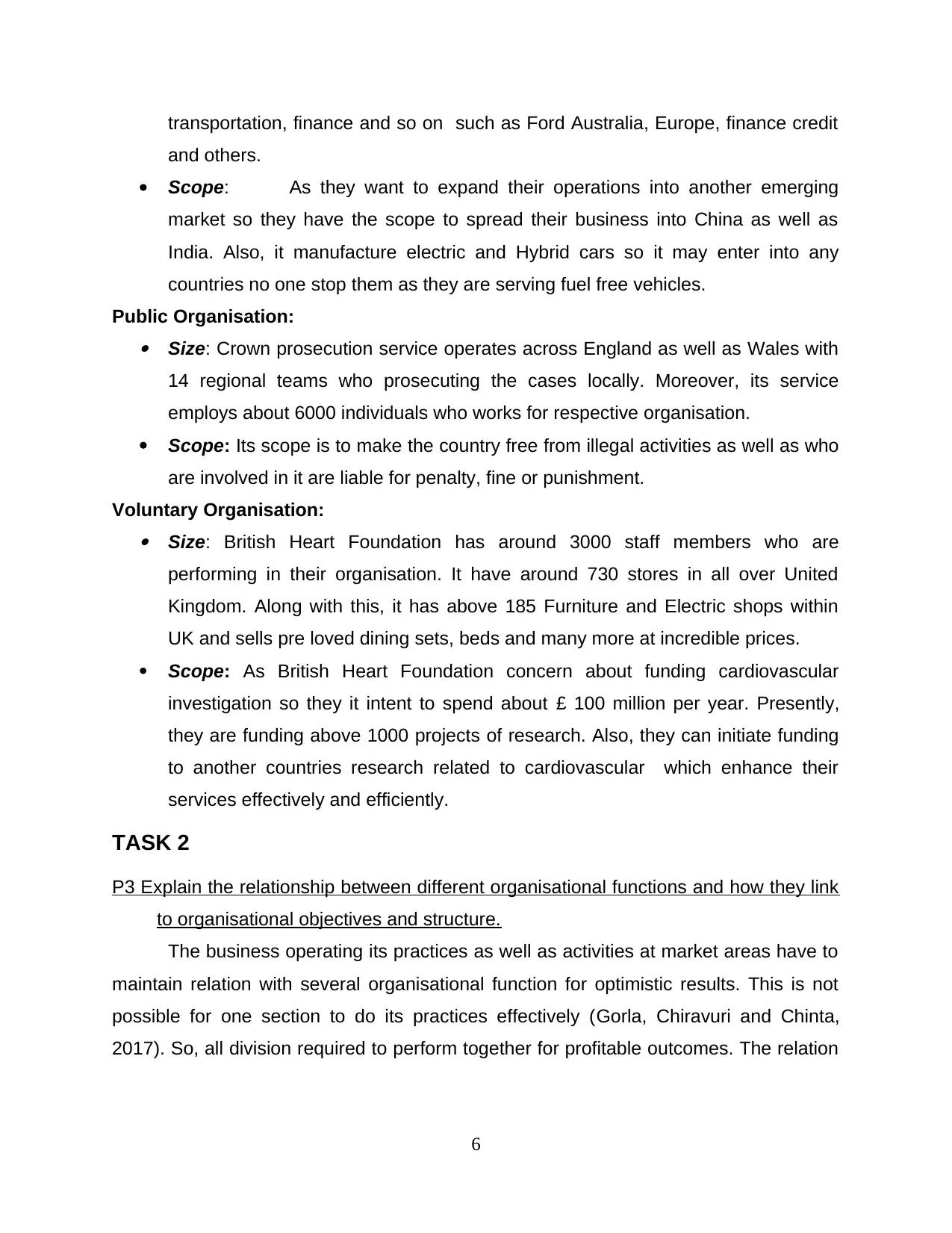
transportation, finance and so on such as Ford Australia, Europe, finance credit
and others.
Scope: As they want to expand their operations into another emerging
market so they have the scope to spread their business into China as well as
India. Also, it manufacture electric and Hybrid cars so it may enter into any
countries no one stop them as they are serving fuel free vehicles.
Public Organisation: Size: Crown prosecution service operates across England as well as Wales with
14 regional teams who prosecuting the cases locally. Moreover, its service
employs about 6000 individuals who works for respective organisation.
Scope: Its scope is to make the country free from illegal activities as well as who
are involved in it are liable for penalty, fine or punishment.
Voluntary Organisation: Size: British Heart Foundation has around 3000 staff members who are
performing in their organisation. It have around 730 stores in all over United
Kingdom. Along with this, it has above 185 Furniture and Electric shops within
UK and sells pre loved dining sets, beds and many more at incredible prices.
Scope: As British Heart Foundation concern about funding cardiovascular
investigation so they it intent to spend about £ 100 million per year. Presently,
they are funding above 1000 projects of research. Also, they can initiate funding
to another countries research related to cardiovascular which enhance their
services effectively and efficiently.
TASK 2
P3 Explain the relationship between different organisational functions and how they link
to organisational objectives and structure.
The business operating its practices as well as activities at market areas have to
maintain relation with several organisational function for optimistic results. This is not
possible for one section to do its practices effectively (Gorla, Chiravuri and Chinta,
2017). So, all division required to perform together for profitable outcomes. The relation
6
and others.
Scope: As they want to expand their operations into another emerging
market so they have the scope to spread their business into China as well as
India. Also, it manufacture electric and Hybrid cars so it may enter into any
countries no one stop them as they are serving fuel free vehicles.
Public Organisation: Size: Crown prosecution service operates across England as well as Wales with
14 regional teams who prosecuting the cases locally. Moreover, its service
employs about 6000 individuals who works for respective organisation.
Scope: Its scope is to make the country free from illegal activities as well as who
are involved in it are liable for penalty, fine or punishment.
Voluntary Organisation: Size: British Heart Foundation has around 3000 staff members who are
performing in their organisation. It have around 730 stores in all over United
Kingdom. Along with this, it has above 185 Furniture and Electric shops within
UK and sells pre loved dining sets, beds and many more at incredible prices.
Scope: As British Heart Foundation concern about funding cardiovascular
investigation so they it intent to spend about £ 100 million per year. Presently,
they are funding above 1000 projects of research. Also, they can initiate funding
to another countries research related to cardiovascular which enhance their
services effectively and efficiently.
TASK 2
P3 Explain the relationship between different organisational functions and how they link
to organisational objectives and structure.
The business operating its practices as well as activities at market areas have to
maintain relation with several organisational function for optimistic results. This is not
possible for one section to do its practices effectively (Gorla, Chiravuri and Chinta,
2017). So, all division required to perform together for profitable outcomes. The relation
6
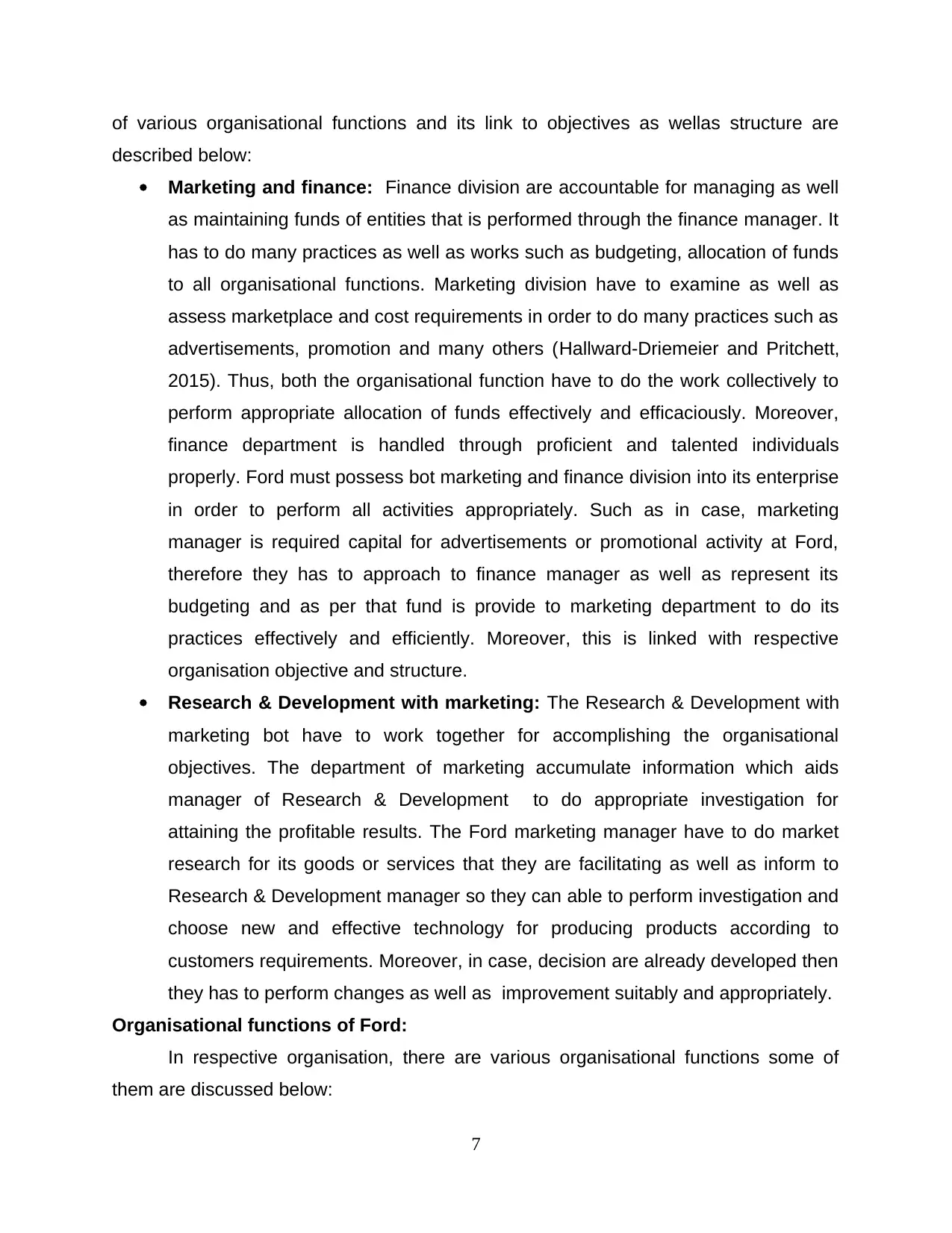
of various organisational functions and its link to objectives as wellas structure are
described below:
Marketing and finance: Finance division are accountable for managing as well
as maintaining funds of entities that is performed through the finance manager. It
has to do many practices as well as works such as budgeting, allocation of funds
to all organisational functions. Marketing division have to examine as well as
assess marketplace and cost requirements in order to do many practices such as
advertisements, promotion and many others (Hallward-Driemeier and Pritchett,
2015). Thus, both the organisational function have to do the work collectively to
perform appropriate allocation of funds effectively and efficaciously. Moreover,
finance department is handled through proficient and talented individuals
properly. Ford must possess bot marketing and finance division into its enterprise
in order to perform all activities appropriately. Such as in case, marketing
manager is required capital for advertisements or promotional activity at Ford,
therefore they has to approach to finance manager as well as represent its
budgeting and as per that fund is provide to marketing department to do its
practices effectively and efficiently. Moreover, this is linked with respective
organisation objective and structure.
Research & Development with marketing: The Research & Development with
marketing bot have to work together for accomplishing the organisational
objectives. The department of marketing accumulate information which aids
manager of Research & Development to do appropriate investigation for
attaining the profitable results. The Ford marketing manager have to do market
research for its goods or services that they are facilitating as well as inform to
Research & Development manager so they can able to perform investigation and
choose new and effective technology for producing products according to
customers requirements. Moreover, in case, decision are already developed then
they has to perform changes as well as improvement suitably and appropriately.
Organisational functions of Ford:
In respective organisation, there are various organisational functions some of
them are discussed below:
7
described below:
Marketing and finance: Finance division are accountable for managing as well
as maintaining funds of entities that is performed through the finance manager. It
has to do many practices as well as works such as budgeting, allocation of funds
to all organisational functions. Marketing division have to examine as well as
assess marketplace and cost requirements in order to do many practices such as
advertisements, promotion and many others (Hallward-Driemeier and Pritchett,
2015). Thus, both the organisational function have to do the work collectively to
perform appropriate allocation of funds effectively and efficaciously. Moreover,
finance department is handled through proficient and talented individuals
properly. Ford must possess bot marketing and finance division into its enterprise
in order to perform all activities appropriately. Such as in case, marketing
manager is required capital for advertisements or promotional activity at Ford,
therefore they has to approach to finance manager as well as represent its
budgeting and as per that fund is provide to marketing department to do its
practices effectively and efficiently. Moreover, this is linked with respective
organisation objective and structure.
Research & Development with marketing: The Research & Development with
marketing bot have to work together for accomplishing the organisational
objectives. The department of marketing accumulate information which aids
manager of Research & Development to do appropriate investigation for
attaining the profitable results. The Ford marketing manager have to do market
research for its goods or services that they are facilitating as well as inform to
Research & Development manager so they can able to perform investigation and
choose new and effective technology for producing products according to
customers requirements. Moreover, in case, decision are already developed then
they has to perform changes as well as improvement suitably and appropriately.
Organisational functions of Ford:
In respective organisation, there are various organisational functions some of
them are discussed below:
7
Secure Best Marks with AI Grader
Need help grading? Try our AI Grader for instant feedback on your assignments.
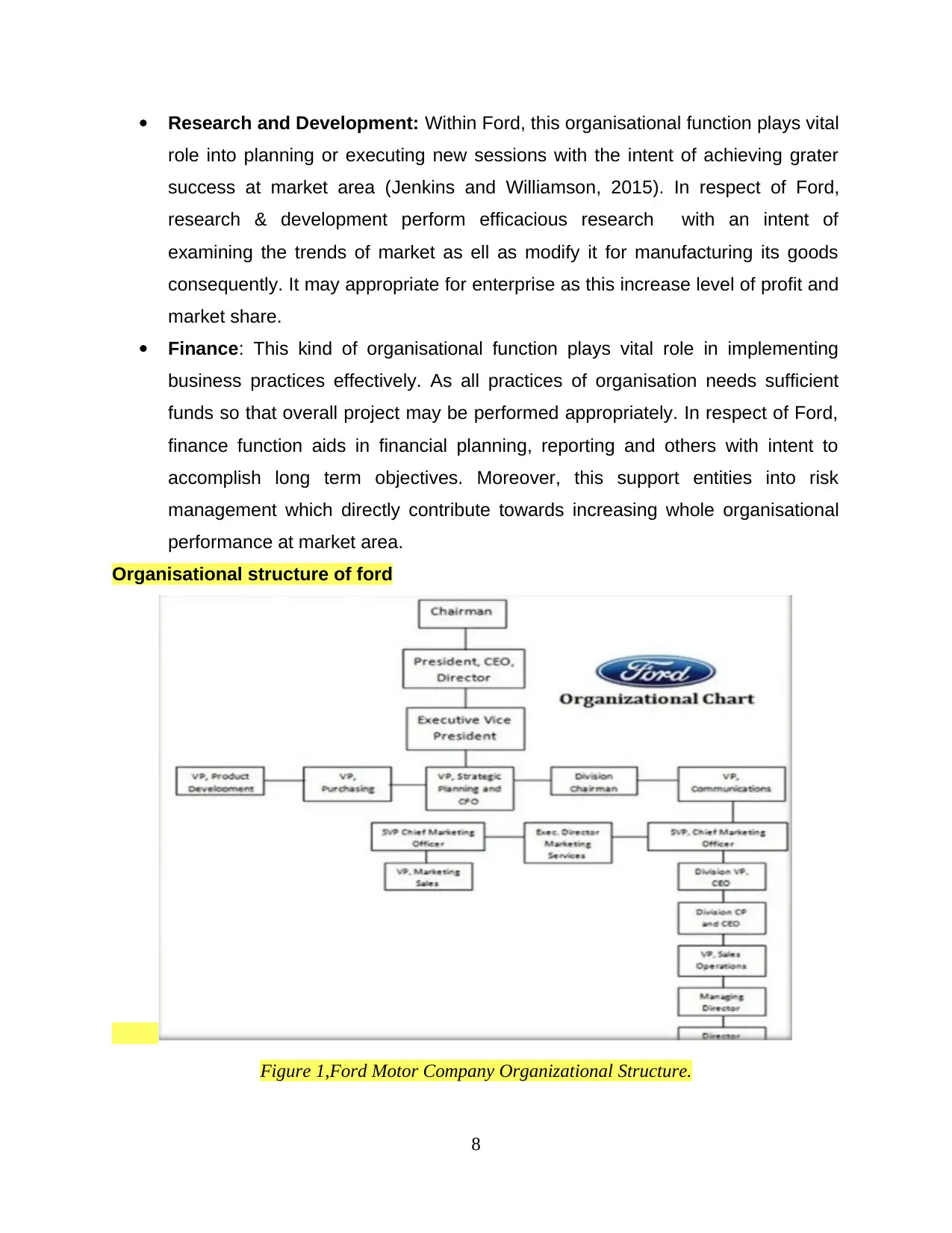
Research and Development: Within Ford, this organisational function plays vital
role into planning or executing new sessions with the intent of achieving grater
success at market area (Jenkins and Williamson, 2015). In respect of Ford,
research & development perform efficacious research with an intent of
examining the trends of market as ell as modify it for manufacturing its goods
consequently. It may appropriate for enterprise as this increase level of profit and
market share.
Finance: This kind of organisational function plays vital role in implementing
business practices effectively. As all practices of organisation needs sufficient
funds so that overall project may be performed appropriately. In respect of Ford,
finance function aids in financial planning, reporting and others with intent to
accomplish long term objectives. Moreover, this support entities into risk
management which directly contribute towards increasing whole organisational
performance at market area.
Organisational structure of ford
Figure 1,Ford Motor Company Organizational Structure.
8
role into planning or executing new sessions with the intent of achieving grater
success at market area (Jenkins and Williamson, 2015). In respect of Ford,
research & development perform efficacious research with an intent of
examining the trends of market as ell as modify it for manufacturing its goods
consequently. It may appropriate for enterprise as this increase level of profit and
market share.
Finance: This kind of organisational function plays vital role in implementing
business practices effectively. As all practices of organisation needs sufficient
funds so that overall project may be performed appropriately. In respect of Ford,
finance function aids in financial planning, reporting and others with intent to
accomplish long term objectives. Moreover, this support entities into risk
management which directly contribute towards increasing whole organisational
performance at market area.
Organisational structure of ford
Figure 1,Ford Motor Company Organizational Structure.
8
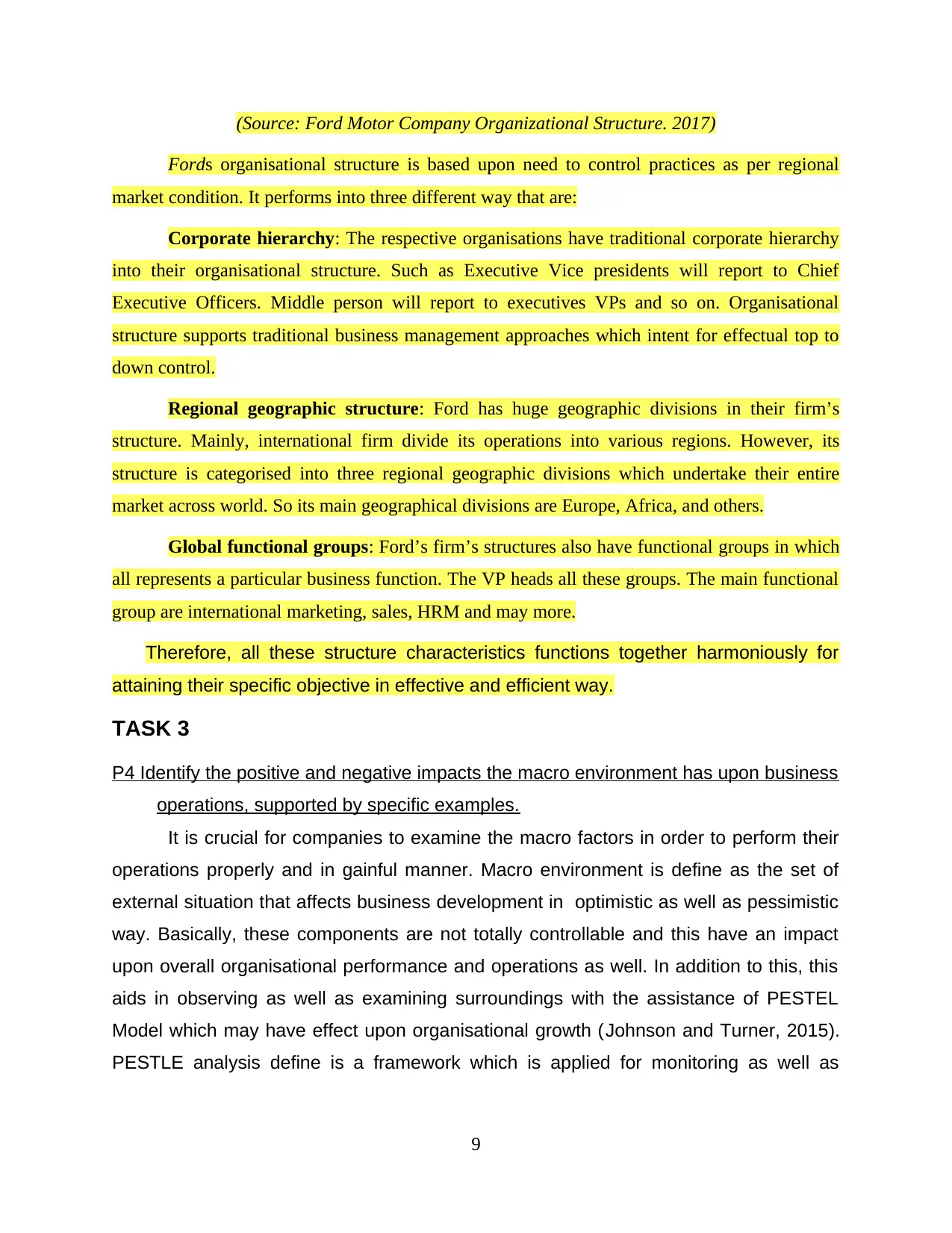
(Source: Ford Motor Company Organizational Structure. 2017)
Fords organisational structure is based upon need to control practices as per regional
market condition. It performs into three different way that are:
Corporate hierarchy: The respective organisations have traditional corporate hierarchy
into their organisational structure. Such as Executive Vice presidents will report to Chief
Executive Officers. Middle person will report to executives VPs and so on. Organisational
structure supports traditional business management approaches which intent for effectual top to
down control.
Regional geographic structure: Ford has huge geographic divisions in their firm’s
structure. Mainly, international firm divide its operations into various regions. However, its
structure is categorised into three regional geographic divisions which undertake their entire
market across world. So its main geographical divisions are Europe, Africa, and others.
Global functional groups: Ford’s firm’s structures also have functional groups in which
all represents a particular business function. The VP heads all these groups. The main functional
group are international marketing, sales, HRM and may more.
Therefore, all these structure characteristics functions together harmoniously for
attaining their specific objective in effective and efficient way.
TASK 3
P4 Identify the positive and negative impacts the macro environment has upon business
operations, supported by specific examples.
It is crucial for companies to examine the macro factors in order to perform their
operations properly and in gainful manner. Macro environment is define as the set of
external situation that affects business development in optimistic as well as pessimistic
way. Basically, these components are not totally controllable and this have an impact
upon overall organisational performance and operations as well. In addition to this, this
aids in observing as well as examining surroundings with the assistance of PESTEL
Model which may have effect upon organisational growth (Johnson and Turner, 2015).
PESTLE analysis define is a framework which is applied for monitoring as well as
9
Fords organisational structure is based upon need to control practices as per regional
market condition. It performs into three different way that are:
Corporate hierarchy: The respective organisations have traditional corporate hierarchy
into their organisational structure. Such as Executive Vice presidents will report to Chief
Executive Officers. Middle person will report to executives VPs and so on. Organisational
structure supports traditional business management approaches which intent for effectual top to
down control.
Regional geographic structure: Ford has huge geographic divisions in their firm’s
structure. Mainly, international firm divide its operations into various regions. However, its
structure is categorised into three regional geographic divisions which undertake their entire
market across world. So its main geographical divisions are Europe, Africa, and others.
Global functional groups: Ford’s firm’s structures also have functional groups in which
all represents a particular business function. The VP heads all these groups. The main functional
group are international marketing, sales, HRM and may more.
Therefore, all these structure characteristics functions together harmoniously for
attaining their specific objective in effective and efficient way.
TASK 3
P4 Identify the positive and negative impacts the macro environment has upon business
operations, supported by specific examples.
It is crucial for companies to examine the macro factors in order to perform their
operations properly and in gainful manner. Macro environment is define as the set of
external situation that affects business development in optimistic as well as pessimistic
way. Basically, these components are not totally controllable and this have an impact
upon overall organisational performance and operations as well. In addition to this, this
aids in observing as well as examining surroundings with the assistance of PESTEL
Model which may have effect upon organisational growth (Johnson and Turner, 2015).
PESTLE analysis define is a framework which is applied for monitoring as well as
9
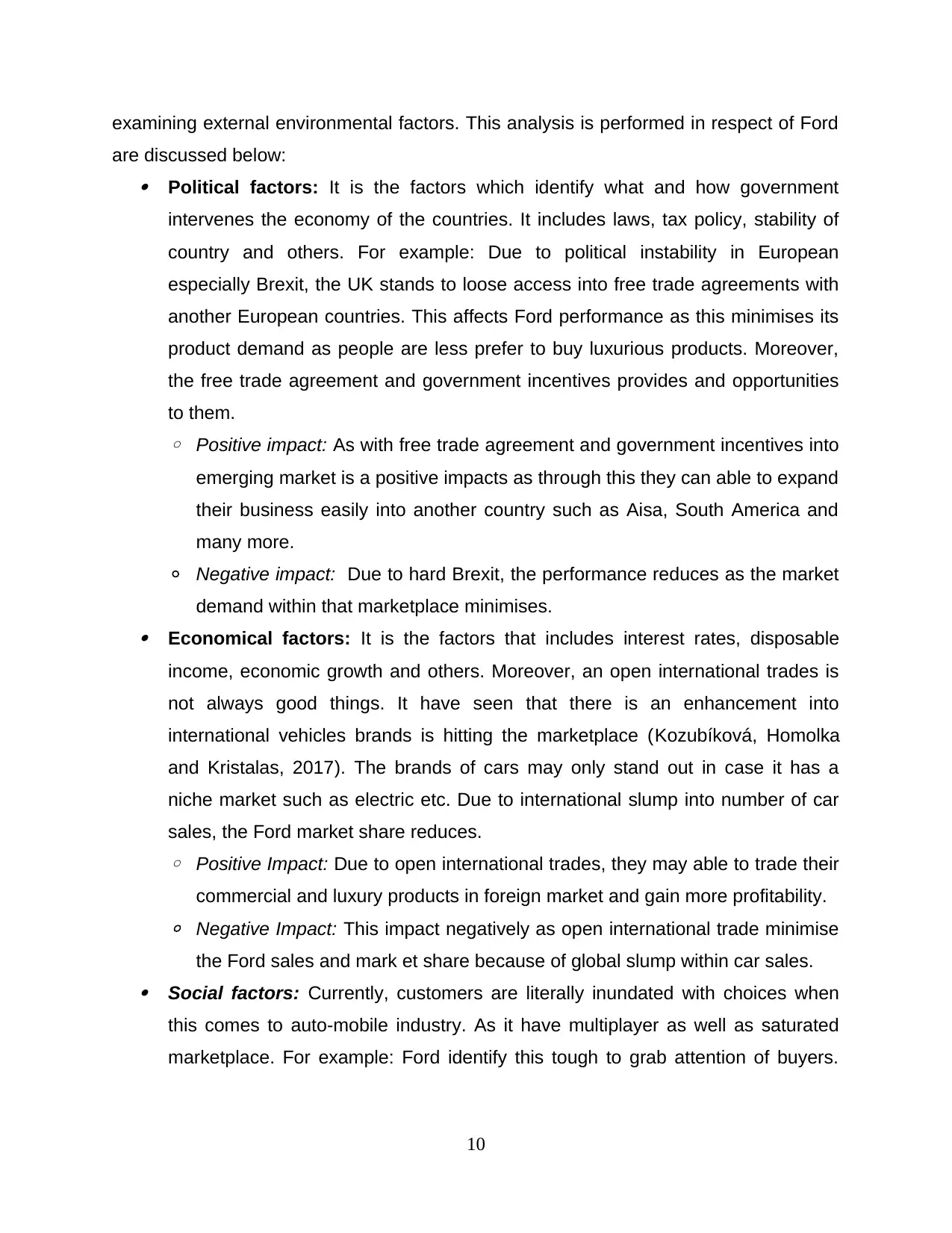
examining external environmental factors. This analysis is performed in respect of Ford
are discussed below: Political factors: It is the factors which identify what and how government
intervenes the economy of the countries. It includes laws, tax policy, stability of
country and others. For example: Due to political instability in European
especially Brexit, the UK stands to loose access into free trade agreements with
another European countries. This affects Ford performance as this minimises its
product demand as people are less prefer to buy luxurious products. Moreover,
the free trade agreement and government incentives provides and opportunities
to them.
◦ Positive impact: As with free trade agreement and government incentives into
emerging market is a positive impacts as through this they can able to expand
their business easily into another country such as Aisa, South America and
many more.
◦ Negative impact: Due to hard Brexit, the performance reduces as the market
demand within that marketplace minimises. Economical factors: It is the factors that includes interest rates, disposable
income, economic growth and others. Moreover, an open international trades is
not always good things. It have seen that there is an enhancement into
international vehicles brands is hitting the marketplace (Kozubíková, Homolka
and Kristalas, 2017). The brands of cars may only stand out in case it has a
niche market such as electric etc. Due to international slump into number of car
sales, the Ford market share reduces.
◦ Positive Impact: Due to open international trades, they may able to trade their
commercial and luxury products in foreign market and gain more profitability.
◦ Negative Impact: This impact negatively as open international trade minimise
the Ford sales and mark et share because of global slump within car sales. Social factors: Currently, customers are literally inundated with choices when
this comes to auto-mobile industry. As it have multiplayer as well as saturated
marketplace. For example: Ford identify this tough to grab attention of buyers.
10
are discussed below: Political factors: It is the factors which identify what and how government
intervenes the economy of the countries. It includes laws, tax policy, stability of
country and others. For example: Due to political instability in European
especially Brexit, the UK stands to loose access into free trade agreements with
another European countries. This affects Ford performance as this minimises its
product demand as people are less prefer to buy luxurious products. Moreover,
the free trade agreement and government incentives provides and opportunities
to them.
◦ Positive impact: As with free trade agreement and government incentives into
emerging market is a positive impacts as through this they can able to expand
their business easily into another country such as Aisa, South America and
many more.
◦ Negative impact: Due to hard Brexit, the performance reduces as the market
demand within that marketplace minimises. Economical factors: It is the factors that includes interest rates, disposable
income, economic growth and others. Moreover, an open international trades is
not always good things. It have seen that there is an enhancement into
international vehicles brands is hitting the marketplace (Kozubíková, Homolka
and Kristalas, 2017). The brands of cars may only stand out in case it has a
niche market such as electric etc. Due to international slump into number of car
sales, the Ford market share reduces.
◦ Positive Impact: Due to open international trades, they may able to trade their
commercial and luxury products in foreign market and gain more profitability.
◦ Negative Impact: This impact negatively as open international trade minimise
the Ford sales and mark et share because of global slump within car sales. Social factors: Currently, customers are literally inundated with choices when
this comes to auto-mobile industry. As it have multiplayer as well as saturated
marketplace. For example: Ford identify this tough to grab attention of buyers.
10
Paraphrase This Document
Need a fresh take? Get an instant paraphrase of this document with our AI Paraphraser
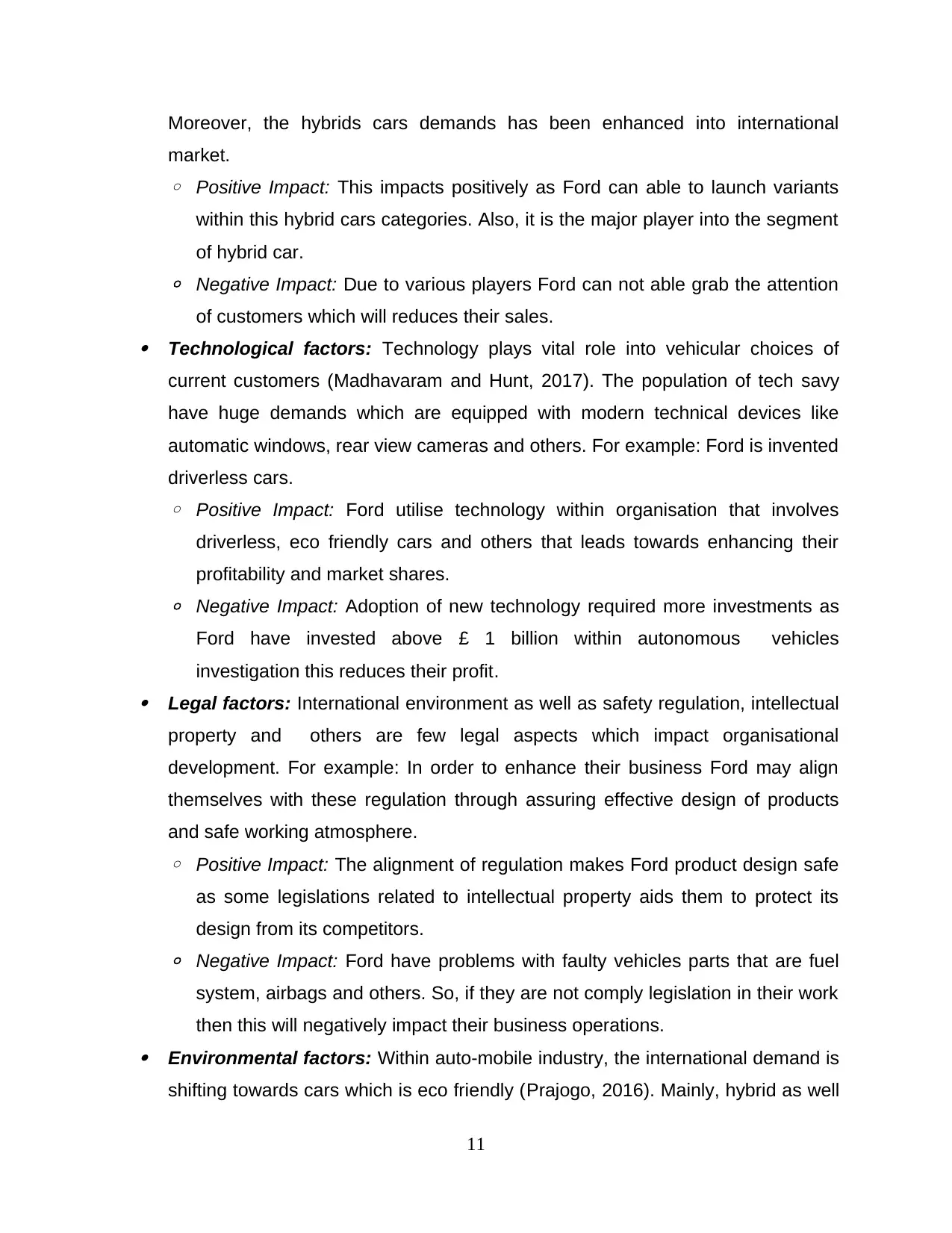
Moreover, the hybrids cars demands has been enhanced into international
market.
◦ Positive Impact: This impacts positively as Ford can able to launch variants
within this hybrid cars categories. Also, it is the major player into the segment
of hybrid car.
◦ Negative Impact: Due to various players Ford can not able grab the attention
of customers which will reduces their sales. Technological factors: Technology plays vital role into vehicular choices of
current customers (Madhavaram and Hunt, 2017). The population of tech savy
have huge demands which are equipped with modern technical devices like
automatic windows, rear view cameras and others. For example: Ford is invented
driverless cars.
◦ Positive Impact: Ford utilise technology within organisation that involves
driverless, eco friendly cars and others that leads towards enhancing their
profitability and market shares.
◦ Negative Impact: Adoption of new technology required more investments as
Ford have invested above £ 1 billion within autonomous vehicles
investigation this reduces their profit. Legal factors: International environment as well as safety regulation, intellectual
property and others are few legal aspects which impact organisational
development. For example: In order to enhance their business Ford may align
themselves with these regulation through assuring effective design of products
and safe working atmosphere.
◦ Positive Impact: The alignment of regulation makes Ford product design safe
as some legislations related to intellectual property aids them to protect its
design from its competitors.
◦ Negative Impact: Ford have problems with faulty vehicles parts that are fuel
system, airbags and others. So, if they are not comply legislation in their work
then this will negatively impact their business operations. Environmental factors: Within auto-mobile industry, the international demand is
shifting towards cars which is eco friendly (Prajogo, 2016). Mainly, hybrid as well
11
market.
◦ Positive Impact: This impacts positively as Ford can able to launch variants
within this hybrid cars categories. Also, it is the major player into the segment
of hybrid car.
◦ Negative Impact: Due to various players Ford can not able grab the attention
of customers which will reduces their sales. Technological factors: Technology plays vital role into vehicular choices of
current customers (Madhavaram and Hunt, 2017). The population of tech savy
have huge demands which are equipped with modern technical devices like
automatic windows, rear view cameras and others. For example: Ford is invented
driverless cars.
◦ Positive Impact: Ford utilise technology within organisation that involves
driverless, eco friendly cars and others that leads towards enhancing their
profitability and market shares.
◦ Negative Impact: Adoption of new technology required more investments as
Ford have invested above £ 1 billion within autonomous vehicles
investigation this reduces their profit. Legal factors: International environment as well as safety regulation, intellectual
property and others are few legal aspects which impact organisational
development. For example: In order to enhance their business Ford may align
themselves with these regulation through assuring effective design of products
and safe working atmosphere.
◦ Positive Impact: The alignment of regulation makes Ford product design safe
as some legislations related to intellectual property aids them to protect its
design from its competitors.
◦ Negative Impact: Ford have problems with faulty vehicles parts that are fuel
system, airbags and others. So, if they are not comply legislation in their work
then this will negatively impact their business operations. Environmental factors: Within auto-mobile industry, the international demand is
shifting towards cars which is eco friendly (Prajogo, 2016). Mainly, hybrid as well
11
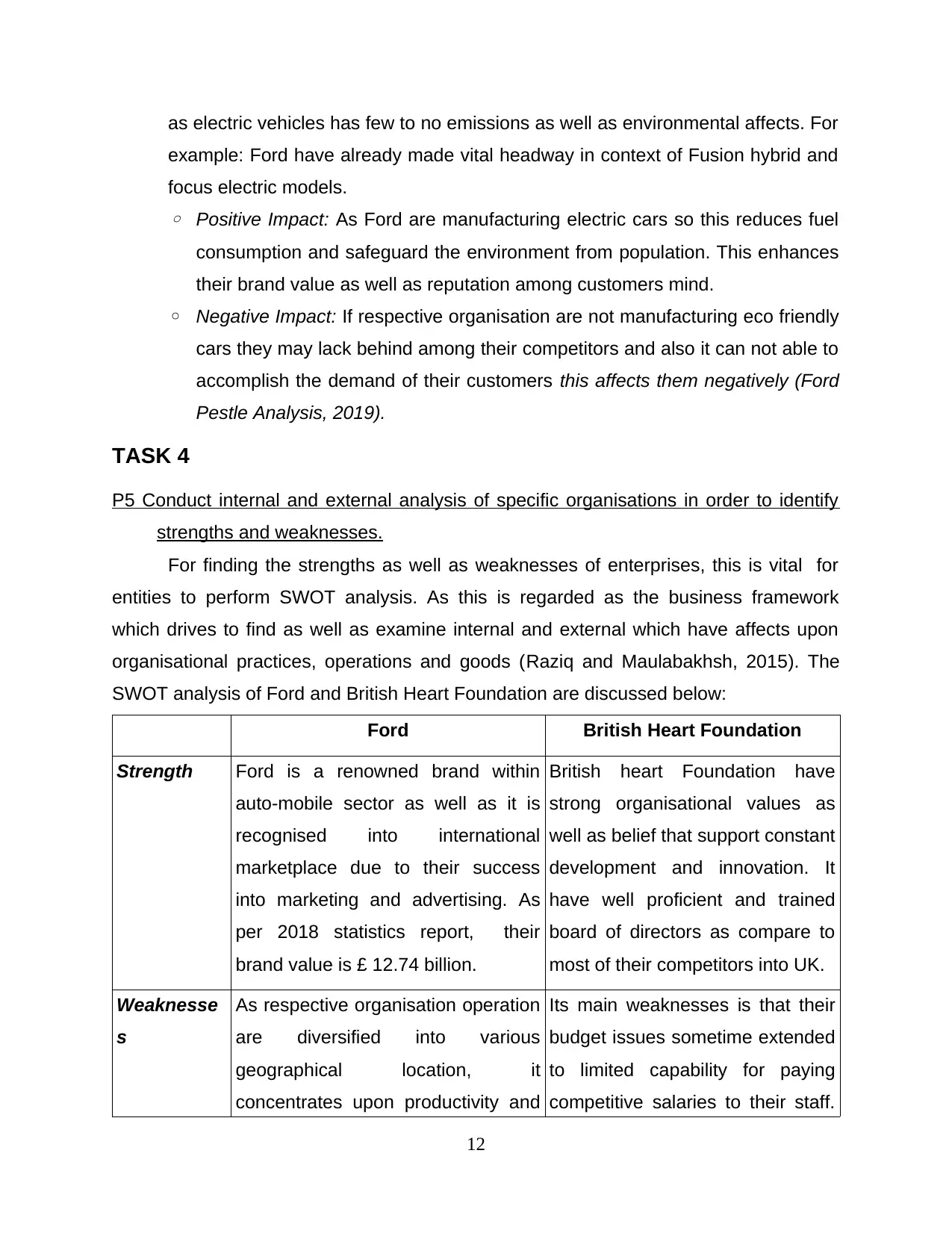
as electric vehicles has few to no emissions as well as environmental affects. For
example: Ford have already made vital headway in context of Fusion hybrid and
focus electric models.
◦ Positive Impact: As Ford are manufacturing electric cars so this reduces fuel
consumption and safeguard the environment from population. This enhances
their brand value as well as reputation among customers mind.
◦ Negative Impact: If respective organisation are not manufacturing eco friendly
cars they may lack behind among their competitors and also it can not able to
accomplish the demand of their customers this affects them negatively (Ford
Pestle Analysis, 2019).
TASK 4
P5 Conduct internal and external analysis of specific organisations in order to identify
strengths and weaknesses.
For finding the strengths as well as weaknesses of enterprises, this is vital for
entities to perform SWOT analysis. As this is regarded as the business framework
which drives to find as well as examine internal and external which have affects upon
organisational practices, operations and goods (Raziq and Maulabakhsh, 2015). The
SWOT analysis of Ford and British Heart Foundation are discussed below:
Ford British Heart Foundation
Strength Ford is a renowned brand within
auto-mobile sector as well as it is
recognised into international
marketplace due to their success
into marketing and advertising. As
per 2018 statistics report, their
brand value is £ 12.74 billion.
British heart Foundation have
strong organisational values as
well as belief that support constant
development and innovation. It
have well proficient and trained
board of directors as compare to
most of their competitors into UK.
Weaknesse
s
As respective organisation operation
are diversified into various
geographical location, it
concentrates upon productivity and
Its main weaknesses is that their
budget issues sometime extended
to limited capability for paying
competitive salaries to their staff.
12
example: Ford have already made vital headway in context of Fusion hybrid and
focus electric models.
◦ Positive Impact: As Ford are manufacturing electric cars so this reduces fuel
consumption and safeguard the environment from population. This enhances
their brand value as well as reputation among customers mind.
◦ Negative Impact: If respective organisation are not manufacturing eco friendly
cars they may lack behind among their competitors and also it can not able to
accomplish the demand of their customers this affects them negatively (Ford
Pestle Analysis, 2019).
TASK 4
P5 Conduct internal and external analysis of specific organisations in order to identify
strengths and weaknesses.
For finding the strengths as well as weaknesses of enterprises, this is vital for
entities to perform SWOT analysis. As this is regarded as the business framework
which drives to find as well as examine internal and external which have affects upon
organisational practices, operations and goods (Raziq and Maulabakhsh, 2015). The
SWOT analysis of Ford and British Heart Foundation are discussed below:
Ford British Heart Foundation
Strength Ford is a renowned brand within
auto-mobile sector as well as it is
recognised into international
marketplace due to their success
into marketing and advertising. As
per 2018 statistics report, their
brand value is £ 12.74 billion.
British heart Foundation have
strong organisational values as
well as belief that support constant
development and innovation. It
have well proficient and trained
board of directors as compare to
most of their competitors into UK.
Weaknesse
s
As respective organisation operation
are diversified into various
geographical location, it
concentrates upon productivity and
Its main weaknesses is that their
budget issues sometime extended
to limited capability for paying
competitive salaries to their staff.
12
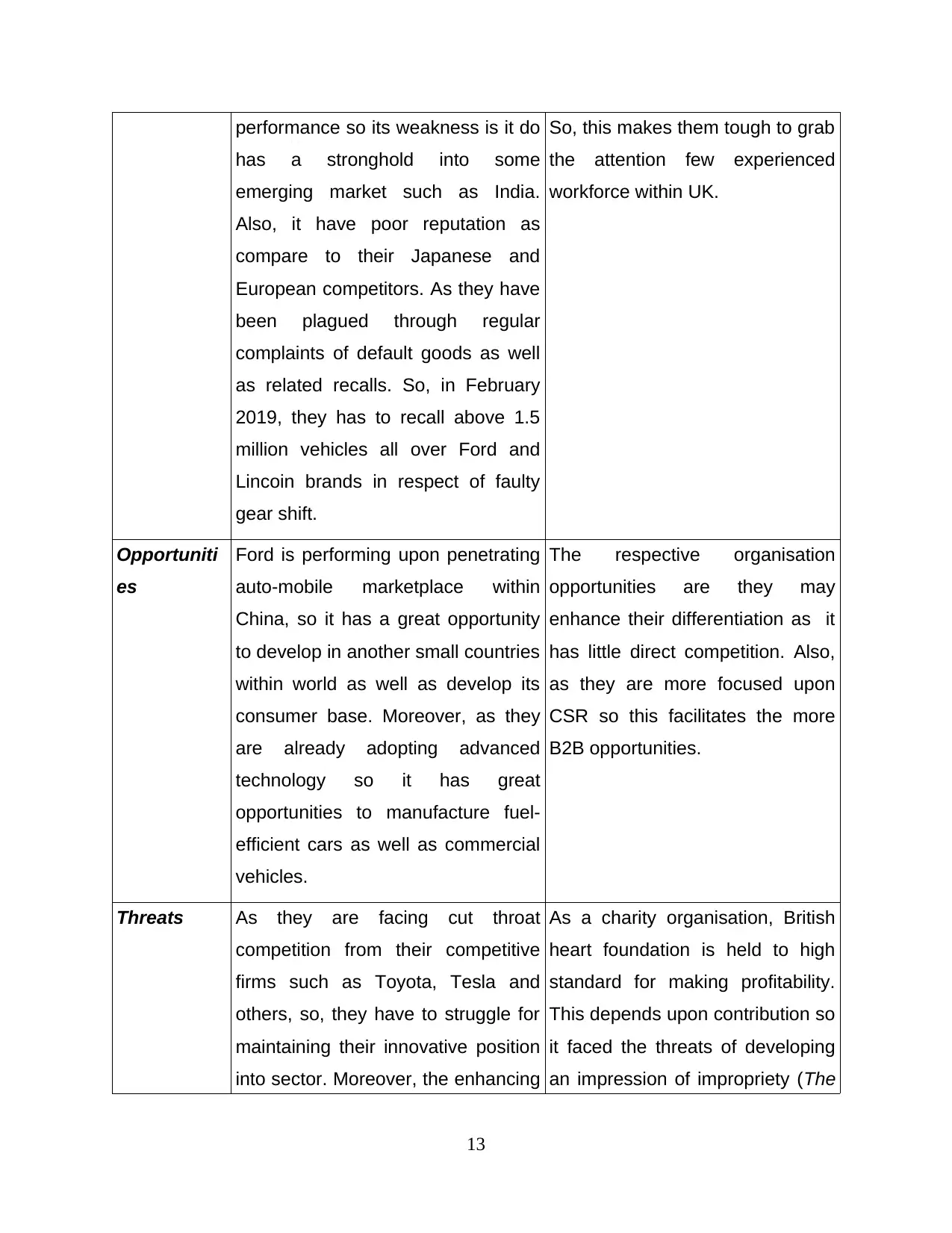
performance so its weakness is it do
has a stronghold into some
emerging market such as India.
Also, it have poor reputation as
compare to their Japanese and
European competitors. As they have
been plagued through regular
complaints of default goods as well
as related recalls. So, in February
2019, they has to recall above 1.5
million vehicles all over Ford and
Lincoin brands in respect of faulty
gear shift.
So, this makes them tough to grab
the attention few experienced
workforce within UK.
Opportuniti
es
Ford is performing upon penetrating
auto-mobile marketplace within
China, so it has a great opportunity
to develop in another small countries
within world as well as develop its
consumer base. Moreover, as they
are already adopting advanced
technology so it has great
opportunities to manufacture fuel-
efficient cars as well as commercial
vehicles.
The respective organisation
opportunities are they may
enhance their differentiation as it
has little direct competition. Also,
as they are more focused upon
CSR so this facilitates the more
B2B opportunities.
Threats As they are facing cut throat
competition from their competitive
firms such as Toyota, Tesla and
others, so, they have to struggle for
maintaining their innovative position
into sector. Moreover, the enhancing
As a charity organisation, British
heart foundation is held to high
standard for making profitability.
This depends upon contribution so
it faced the threats of developing
an impression of impropriety (The
13
has a stronghold into some
emerging market such as India.
Also, it have poor reputation as
compare to their Japanese and
European competitors. As they have
been plagued through regular
complaints of default goods as well
as related recalls. So, in February
2019, they has to recall above 1.5
million vehicles all over Ford and
Lincoin brands in respect of faulty
gear shift.
So, this makes them tough to grab
the attention few experienced
workforce within UK.
Opportuniti
es
Ford is performing upon penetrating
auto-mobile marketplace within
China, so it has a great opportunity
to develop in another small countries
within world as well as develop its
consumer base. Moreover, as they
are already adopting advanced
technology so it has great
opportunities to manufacture fuel-
efficient cars as well as commercial
vehicles.
The respective organisation
opportunities are they may
enhance their differentiation as it
has little direct competition. Also,
as they are more focused upon
CSR so this facilitates the more
B2B opportunities.
Threats As they are facing cut throat
competition from their competitive
firms such as Toyota, Tesla and
others, so, they have to struggle for
maintaining their innovative position
into sector. Moreover, the enhancing
As a charity organisation, British
heart foundation is held to high
standard for making profitability.
This depends upon contribution so
it faced the threats of developing
an impression of impropriety (The
13
Secure Best Marks with AI Grader
Need help grading? Try our AI Grader for instant feedback on your assignments.
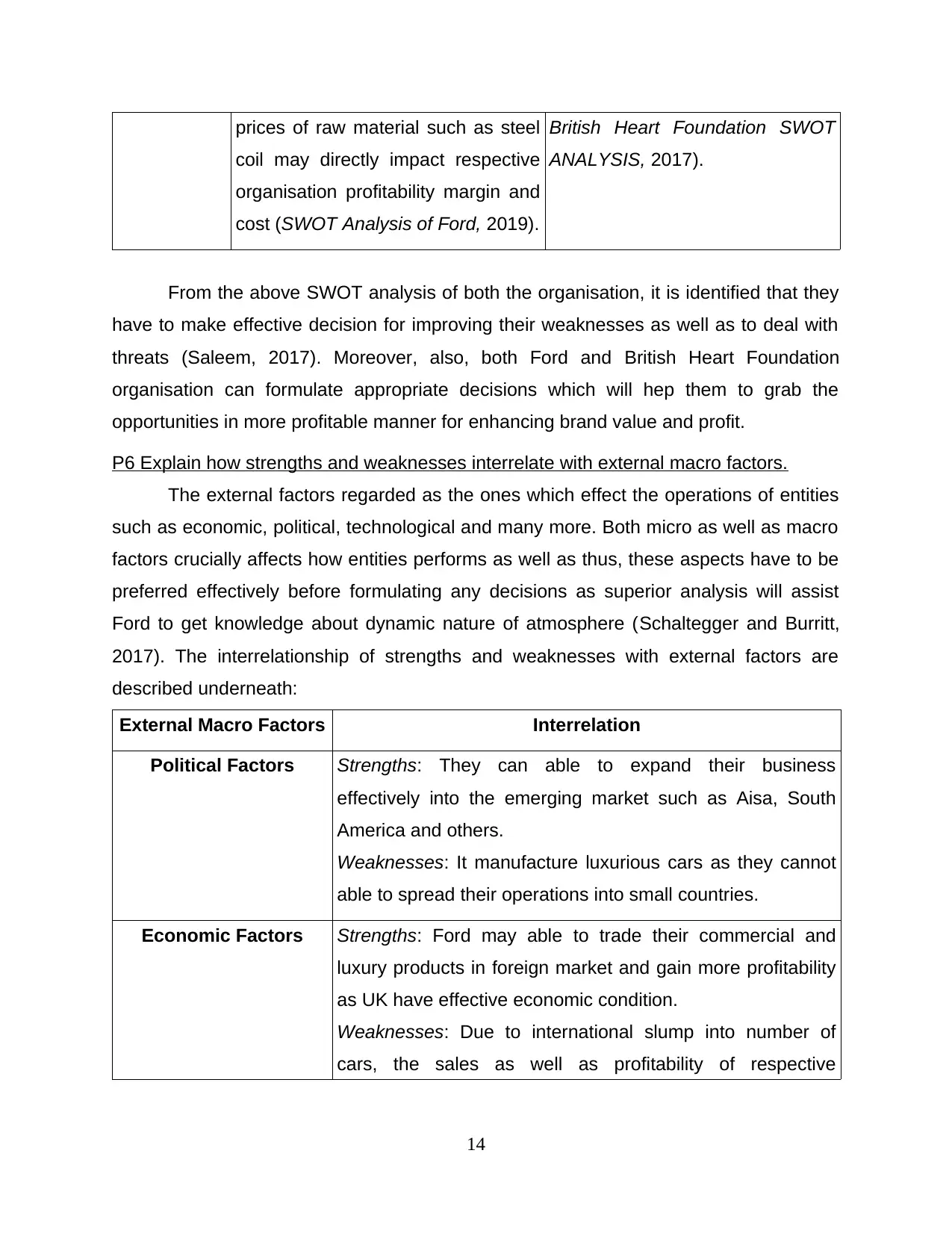
prices of raw material such as steel
coil may directly impact respective
organisation profitability margin and
cost (SWOT Analysis of Ford, 2019).
British Heart Foundation SWOT
ANALYSIS, 2017).
From the above SWOT analysis of both the organisation, it is identified that they
have to make effective decision for improving their weaknesses as well as to deal with
threats (Saleem, 2017). Moreover, also, both Ford and British Heart Foundation
organisation can formulate appropriate decisions which will hep them to grab the
opportunities in more profitable manner for enhancing brand value and profit.
P6 Explain how strengths and weaknesses interrelate with external macro factors.
The external factors regarded as the ones which effect the operations of entities
such as economic, political, technological and many more. Both micro as well as macro
factors crucially affects how entities performs as well as thus, these aspects have to be
preferred effectively before formulating any decisions as superior analysis will assist
Ford to get knowledge about dynamic nature of atmosphere (Schaltegger and Burritt,
2017). The interrelationship of strengths and weaknesses with external factors are
described underneath:
External Macro Factors Interrelation
Political Factors Strengths: They can able to expand their business
effectively into the emerging market such as Aisa, South
America and others.
Weaknesses: It manufacture luxurious cars as they cannot
able to spread their operations into small countries.
Economic Factors Strengths: Ford may able to trade their commercial and
luxury products in foreign market and gain more profitability
as UK have effective economic condition.
Weaknesses: Due to international slump into number of
cars, the sales as well as profitability of respective
14
coil may directly impact respective
organisation profitability margin and
cost (SWOT Analysis of Ford, 2019).
British Heart Foundation SWOT
ANALYSIS, 2017).
From the above SWOT analysis of both the organisation, it is identified that they
have to make effective decision for improving their weaknesses as well as to deal with
threats (Saleem, 2017). Moreover, also, both Ford and British Heart Foundation
organisation can formulate appropriate decisions which will hep them to grab the
opportunities in more profitable manner for enhancing brand value and profit.
P6 Explain how strengths and weaknesses interrelate with external macro factors.
The external factors regarded as the ones which effect the operations of entities
such as economic, political, technological and many more. Both micro as well as macro
factors crucially affects how entities performs as well as thus, these aspects have to be
preferred effectively before formulating any decisions as superior analysis will assist
Ford to get knowledge about dynamic nature of atmosphere (Schaltegger and Burritt,
2017). The interrelationship of strengths and weaknesses with external factors are
described underneath:
External Macro Factors Interrelation
Political Factors Strengths: They can able to expand their business
effectively into the emerging market such as Aisa, South
America and others.
Weaknesses: It manufacture luxurious cars as they cannot
able to spread their operations into small countries.
Economic Factors Strengths: Ford may able to trade their commercial and
luxury products in foreign market and gain more profitability
as UK have effective economic condition.
Weaknesses: Due to international slump into number of
cars, the sales as well as profitability of respective
14
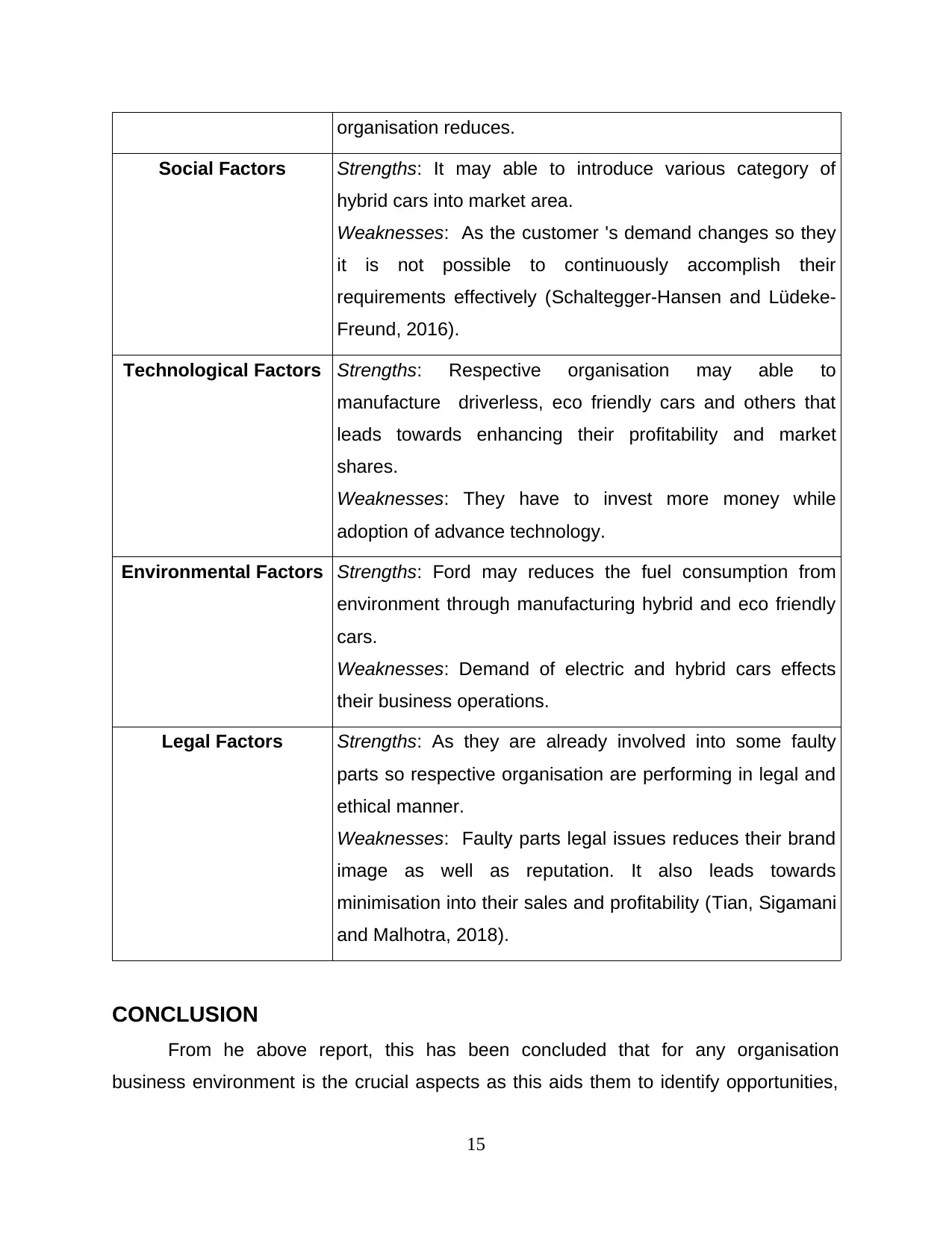
organisation reduces.
Social Factors Strengths: It may able to introduce various category of
hybrid cars into market area.
Weaknesses: As the customer 's demand changes so they
it is not possible to continuously accomplish their
requirements effectively (Schaltegger-Hansen and Lüdeke-
Freund, 2016).
Technological Factors Strengths: Respective organisation may able to
manufacture driverless, eco friendly cars and others that
leads towards enhancing their profitability and market
shares.
Weaknesses: They have to invest more money while
adoption of advance technology.
Environmental Factors Strengths: Ford may reduces the fuel consumption from
environment through manufacturing hybrid and eco friendly
cars.
Weaknesses: Demand of electric and hybrid cars effects
their business operations.
Legal Factors Strengths: As they are already involved into some faulty
parts so respective organisation are performing in legal and
ethical manner.
Weaknesses: Faulty parts legal issues reduces their brand
image as well as reputation. It also leads towards
minimisation into their sales and profitability (Tian, Sigamani
and Malhotra, 2018).
CONCLUSION
From he above report, this has been concluded that for any organisation
business environment is the crucial aspects as this aids them to identify opportunities,
15
Social Factors Strengths: It may able to introduce various category of
hybrid cars into market area.
Weaknesses: As the customer 's demand changes so they
it is not possible to continuously accomplish their
requirements effectively (Schaltegger-Hansen and Lüdeke-
Freund, 2016).
Technological Factors Strengths: Respective organisation may able to
manufacture driverless, eco friendly cars and others that
leads towards enhancing their profitability and market
shares.
Weaknesses: They have to invest more money while
adoption of advance technology.
Environmental Factors Strengths: Ford may reduces the fuel consumption from
environment through manufacturing hybrid and eco friendly
cars.
Weaknesses: Demand of electric and hybrid cars effects
their business operations.
Legal Factors Strengths: As they are already involved into some faulty
parts so respective organisation are performing in legal and
ethical manner.
Weaknesses: Faulty parts legal issues reduces their brand
image as well as reputation. It also leads towards
minimisation into their sales and profitability (Tian, Sigamani
and Malhotra, 2018).
CONCLUSION
From he above report, this has been concluded that for any organisation
business environment is the crucial aspects as this aids them to identify opportunities,
15
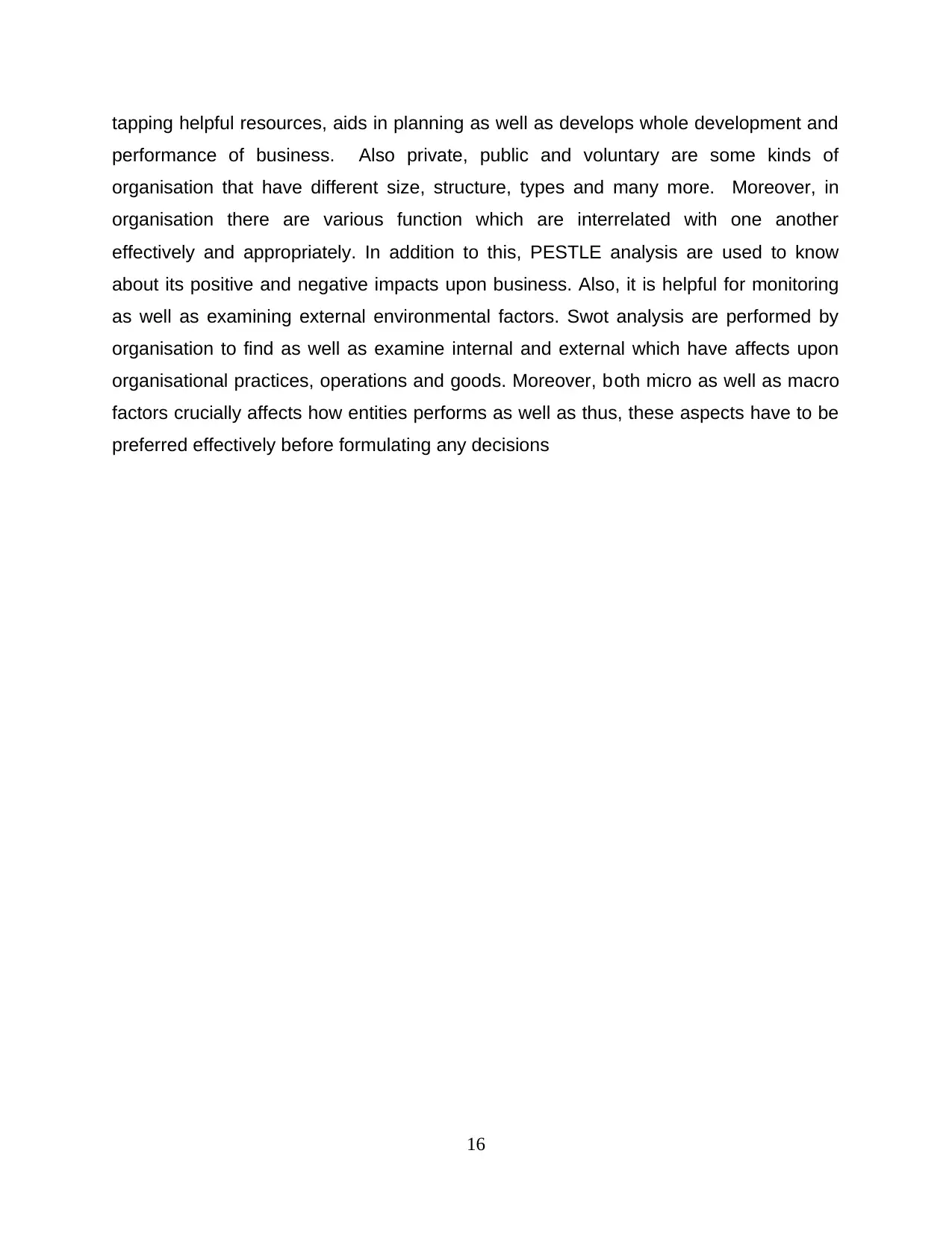
tapping helpful resources, aids in planning as well as develops whole development and
performance of business. Also private, public and voluntary are some kinds of
organisation that have different size, structure, types and many more. Moreover, in
organisation there are various function which are interrelated with one another
effectively and appropriately. In addition to this, PESTLE analysis are used to know
about its positive and negative impacts upon business. Also, it is helpful for monitoring
as well as examining external environmental factors. Swot analysis are performed by
organisation to find as well as examine internal and external which have affects upon
organisational practices, operations and goods. Moreover, both micro as well as macro
factors crucially affects how entities performs as well as thus, these aspects have to be
preferred effectively before formulating any decisions
16
performance of business. Also private, public and voluntary are some kinds of
organisation that have different size, structure, types and many more. Moreover, in
organisation there are various function which are interrelated with one another
effectively and appropriately. In addition to this, PESTLE analysis are used to know
about its positive and negative impacts upon business. Also, it is helpful for monitoring
as well as examining external environmental factors. Swot analysis are performed by
organisation to find as well as examine internal and external which have affects upon
organisational practices, operations and goods. Moreover, both micro as well as macro
factors crucially affects how entities performs as well as thus, these aspects have to be
preferred effectively before formulating any decisions
16
Paraphrase This Document
Need a fresh take? Get an instant paraphrase of this document with our AI Paraphraser
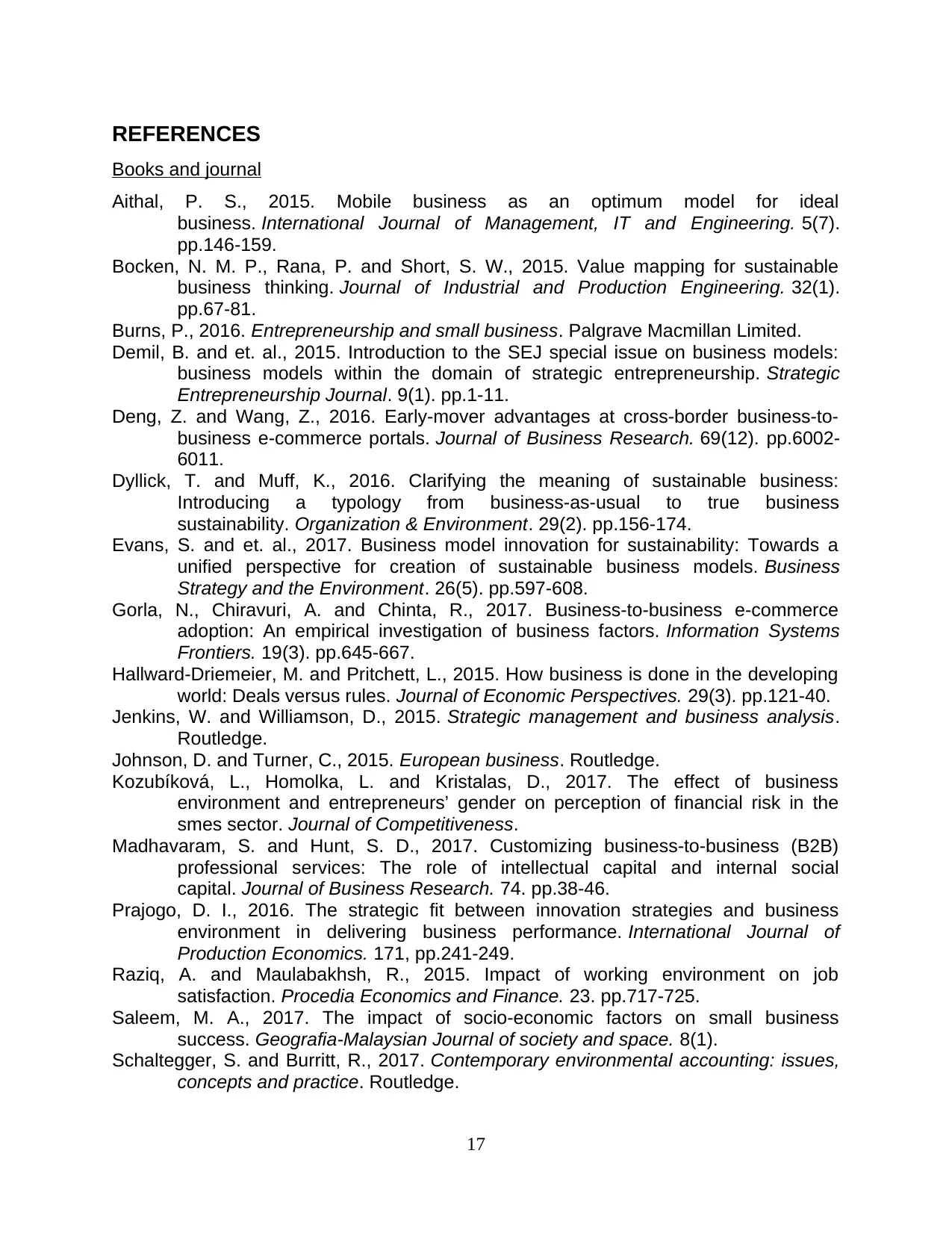
REFERENCES
Books and journal
Aithal, P. S., 2015. Mobile business as an optimum model for ideal
business. International Journal of Management, IT and Engineering. 5(7).
pp.146-159.
Bocken, N. M. P., Rana, P. and Short, S. W., 2015. Value mapping for sustainable
business thinking. Journal of Industrial and Production Engineering. 32(1).
pp.67-81.
Burns, P., 2016. Entrepreneurship and small business. Palgrave Macmillan Limited.
Demil, B. and et. al., 2015. Introduction to the SEJ special issue on business models:
business models within the domain of strategic entrepreneurship. Strategic
Entrepreneurship Journal. 9(1). pp.1-11.
Deng, Z. and Wang, Z., 2016. Early-mover advantages at cross-border business-to-
business e-commerce portals. Journal of Business Research. 69(12). pp.6002-
6011.
Dyllick, T. and Muff, K., 2016. Clarifying the meaning of sustainable business:
Introducing a typology from business-as-usual to true business
sustainability. Organization & Environment. 29(2). pp.156-174.
Evans, S. and et. al., 2017. Business model innovation for sustainability: Towards a
unified perspective for creation of sustainable business models. Business
Strategy and the Environment. 26(5). pp.597-608.
Gorla, N., Chiravuri, A. and Chinta, R., 2017. Business-to-business e-commerce
adoption: An empirical investigation of business factors. Information Systems
Frontiers. 19(3). pp.645-667.
Hallward-Driemeier, M. and Pritchett, L., 2015. How business is done in the developing
world: Deals versus rules. Journal of Economic Perspectives. 29(3). pp.121-40.
Jenkins, W. and Williamson, D., 2015. Strategic management and business analysis.
Routledge.
Johnson, D. and Turner, C., 2015. European business. Routledge.
Kozubíková, L., Homolka, L. and Kristalas, D., 2017. The effect of business
environment and entrepreneurs’ gender on perception of financial risk in the
smes sector. Journal of Competitiveness.
Madhavaram, S. and Hunt, S. D., 2017. Customizing business-to-business (B2B)
professional services: The role of intellectual capital and internal social
capital. Journal of Business Research. 74. pp.38-46.
Prajogo, D. I., 2016. The strategic fit between innovation strategies and business
environment in delivering business performance. International Journal of
Production Economics. 171, pp.241-249.
Raziq, A. and Maulabakhsh, R., 2015. Impact of working environment on job
satisfaction. Procedia Economics and Finance. 23. pp.717-725.
Saleem, M. A., 2017. The impact of socio-economic factors on small business
success. Geografia-Malaysian Journal of society and space. 8(1).
Schaltegger, S. and Burritt, R., 2017. Contemporary environmental accounting: issues,
concepts and practice. Routledge.
17
Books and journal
Aithal, P. S., 2015. Mobile business as an optimum model for ideal
business. International Journal of Management, IT and Engineering. 5(7).
pp.146-159.
Bocken, N. M. P., Rana, P. and Short, S. W., 2015. Value mapping for sustainable
business thinking. Journal of Industrial and Production Engineering. 32(1).
pp.67-81.
Burns, P., 2016. Entrepreneurship and small business. Palgrave Macmillan Limited.
Demil, B. and et. al., 2015. Introduction to the SEJ special issue on business models:
business models within the domain of strategic entrepreneurship. Strategic
Entrepreneurship Journal. 9(1). pp.1-11.
Deng, Z. and Wang, Z., 2016. Early-mover advantages at cross-border business-to-
business e-commerce portals. Journal of Business Research. 69(12). pp.6002-
6011.
Dyllick, T. and Muff, K., 2016. Clarifying the meaning of sustainable business:
Introducing a typology from business-as-usual to true business
sustainability. Organization & Environment. 29(2). pp.156-174.
Evans, S. and et. al., 2017. Business model innovation for sustainability: Towards a
unified perspective for creation of sustainable business models. Business
Strategy and the Environment. 26(5). pp.597-608.
Gorla, N., Chiravuri, A. and Chinta, R., 2017. Business-to-business e-commerce
adoption: An empirical investigation of business factors. Information Systems
Frontiers. 19(3). pp.645-667.
Hallward-Driemeier, M. and Pritchett, L., 2015. How business is done in the developing
world: Deals versus rules. Journal of Economic Perspectives. 29(3). pp.121-40.
Jenkins, W. and Williamson, D., 2015. Strategic management and business analysis.
Routledge.
Johnson, D. and Turner, C., 2015. European business. Routledge.
Kozubíková, L., Homolka, L. and Kristalas, D., 2017. The effect of business
environment and entrepreneurs’ gender on perception of financial risk in the
smes sector. Journal of Competitiveness.
Madhavaram, S. and Hunt, S. D., 2017. Customizing business-to-business (B2B)
professional services: The role of intellectual capital and internal social
capital. Journal of Business Research. 74. pp.38-46.
Prajogo, D. I., 2016. The strategic fit between innovation strategies and business
environment in delivering business performance. International Journal of
Production Economics. 171, pp.241-249.
Raziq, A. and Maulabakhsh, R., 2015. Impact of working environment on job
satisfaction. Procedia Economics and Finance. 23. pp.717-725.
Saleem, M. A., 2017. The impact of socio-economic factors on small business
success. Geografia-Malaysian Journal of society and space. 8(1).
Schaltegger, S. and Burritt, R., 2017. Contemporary environmental accounting: issues,
concepts and practice. Routledge.
17
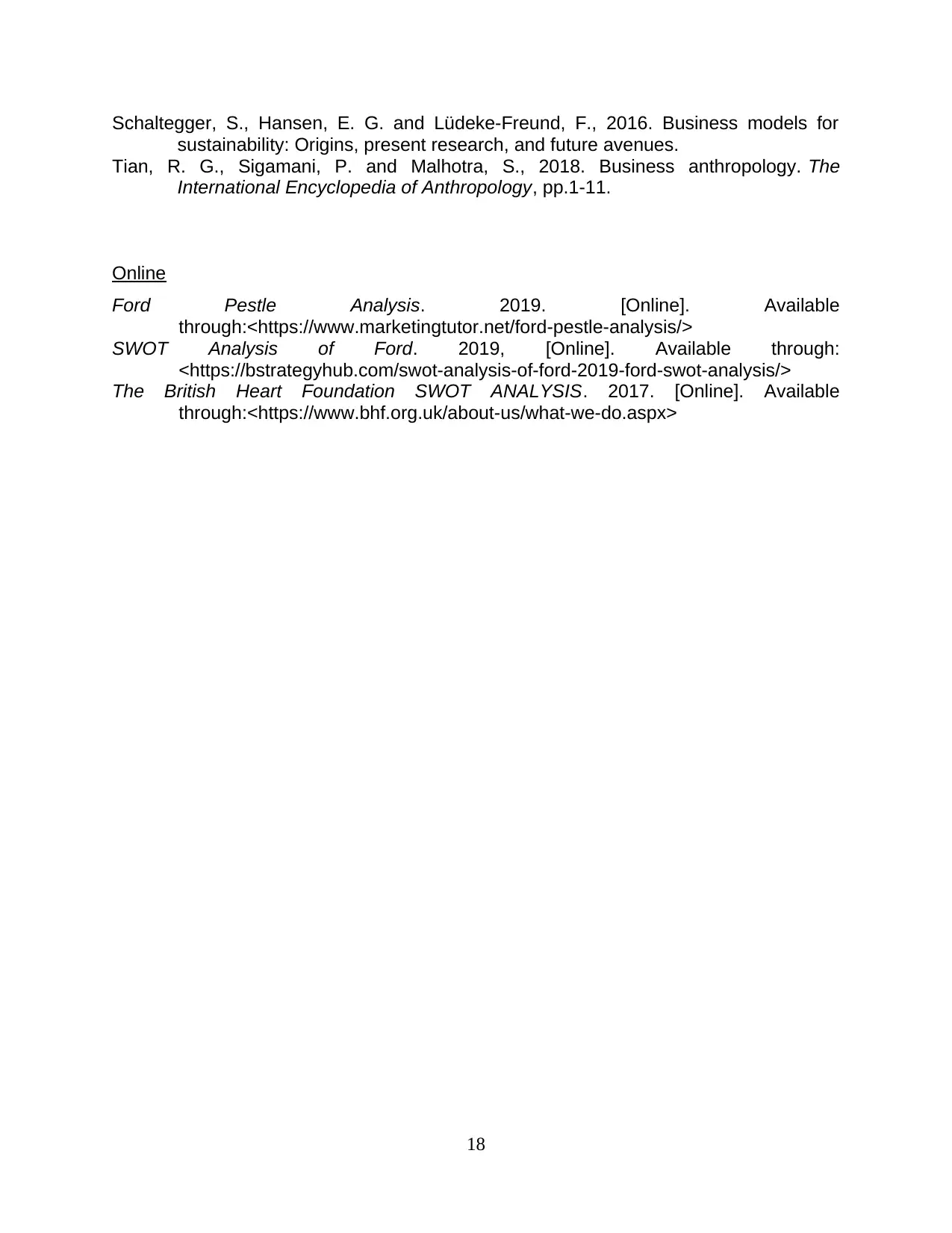
Schaltegger, S., Hansen, E. G. and Lüdeke-Freund, F., 2016. Business models for
sustainability: Origins, present research, and future avenues.
Tian, R. G., Sigamani, P. and Malhotra, S., 2018. Business anthropology. The
International Encyclopedia of Anthropology, pp.1-11.
Online
Ford Pestle Analysis. 2019. [Online]. Available
through:<https://www.marketingtutor.net/ford-pestle-analysis/>
SWOT Analysis of Ford. 2019, [Online]. Available through:
<https://bstrategyhub.com/swot-analysis-of-ford-2019-ford-swot-analysis/>
The British Heart Foundation SWOT ANALYSIS. 2017. [Online]. Available
through:<https://www.bhf.org.uk/about-us/what-we-do.aspx>
18
sustainability: Origins, present research, and future avenues.
Tian, R. G., Sigamani, P. and Malhotra, S., 2018. Business anthropology. The
International Encyclopedia of Anthropology, pp.1-11.
Online
Ford Pestle Analysis. 2019. [Online]. Available
through:<https://www.marketingtutor.net/ford-pestle-analysis/>
SWOT Analysis of Ford. 2019, [Online]. Available through:
<https://bstrategyhub.com/swot-analysis-of-ford-2019-ford-swot-analysis/>
The British Heart Foundation SWOT ANALYSIS. 2017. [Online]. Available
through:<https://www.bhf.org.uk/about-us/what-we-do.aspx>
18
1 out of 21
Related Documents
Your All-in-One AI-Powered Toolkit for Academic Success.
+13062052269
info@desklib.com
Available 24*7 on WhatsApp / Email
![[object Object]](/_next/static/media/star-bottom.7253800d.svg)
Unlock your academic potential
© 2024 | Zucol Services PVT LTD | All rights reserved.





